Categories
- Argentina
- Chile
- Antarctica
- Easter Island
- Falklands (Malvinas)
- Bolivia
- Peru
- Uruguay
- Paraguay
- Brazil
- Venezuela
- Colombia
- Ecuador
- Galapagos
- Panama
- Costa Rica
- Cuba
- Nicaragua
- Honduras
- El Salvador
- Guatemala
- Belize
- Mexico
- Latin American Xmas
Pages
- Street Art of Buenos Aires
- A week in Buenos Aires
- The Jesuit Missions in South America
- Contact Us
- Map of Central America
- First week in Latin America – October 2009
- Home Page
- Map of South America
Archives
- October 2011 (3)
- September 2011 (9)
- August 2011 (10)
- July 2011 (7)
- June 2011 (6)
- May 2011 (11)
- April 2011 (10)
- March 2011 (4)
- February 2011 (5)
- January 2011 (6)
- December 2010 (6)
- November 2010 (4)
- October 2010 (8)
- September 2010 (5)
- August 2010 (7)
- July 2010 (5)
- June 2010 (6)
- May 2010 (6)
- April 2010 (7)
- March 2010 (6)
- February 2010 (9)
- January 2010 (4)
- December 2009 (8)
- November 2009 (5)
- October 2009 (2)
Xmas in Popayán
26th December 2010
Popayán [10] is another beautiful, old colonial town and a pleasant place to spend a few days. The tamales here are the best we´ve had. Chicken and meat, combined with slices of potato, chick peas, peanuts and a corn mixture, is wrapped together in banana leaves and steamed to make a delicious and filling meal.
.
We arrived in Popayán on Christmas Eve after a slow, bumpy bus ride through the mountains from San Agustín, 6 hours to do 120 kilometres. The road was rough but the scenery magnificent. Our hostel, Hostel Trail had organised Christmas drinks and food that evening and a lovely traditional lunch for all the hostel guests on Christmas day at a nearby restaurant.
.
On Tuesdays, the nearby village of Silvia [11] comes alive. The local Guambiano Indians, in colourful traditional dress, come to buy and sell fruit, vegetables and meat at the weekly market.
.
Tierradentro [12] (meaning under the ground), four and a half hours away by local bus is another important archaeological site. Our 5 am bus soon filled with families and farmers taking produce and fresh milk to market as it climbed above 3000 meters passing forests, fields and farms.
About 100 tombs have been discovered in the hillsides as well as a few stone statues. Each tomb is accessed by a well about 2 meters in diameter with spiral or zigzag stairs leading down to the tomb which can be as much as 5 meters deep. They range from 2 to 7 metres across with huge carved pillars. Domed ceilings and the walls are painted with geometric designs in red and black, some remarkably well preserved. This burial method is different to that used in San Agustín and unique in the Americas. We followed the path uphill and along the valley, passing the sites, to arrive at San Andrés de Pisimbalá where we found cold beer, delicious food and a good bed at La Portada.
.
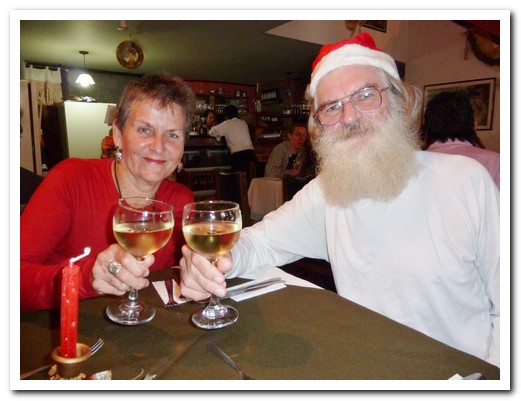
Xmas dinner in Popayán
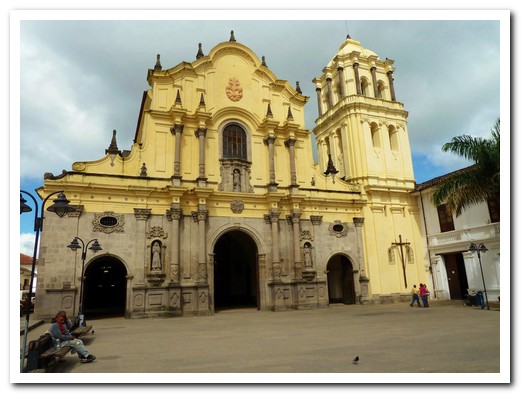
The yellow Iglesia San Francisco
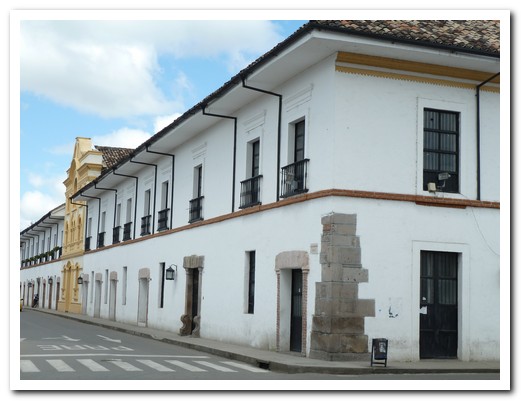
The old part of Popayán
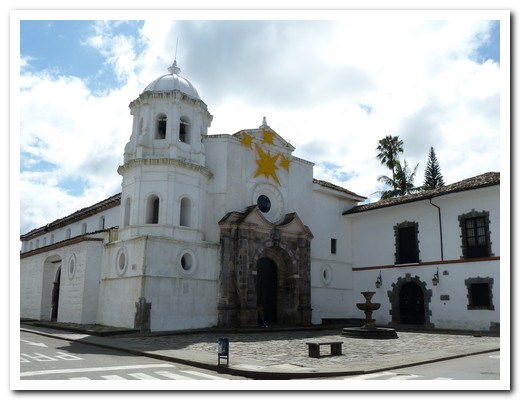
Iglesia Santo Domingo
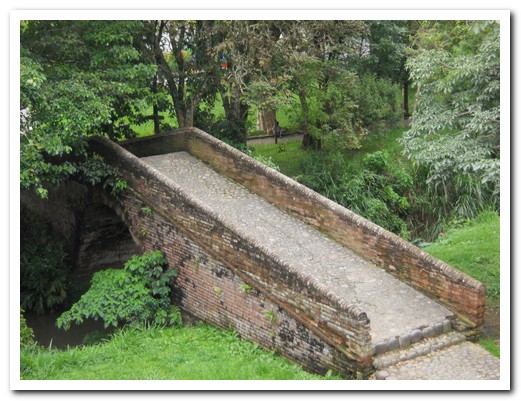
1713 bridge
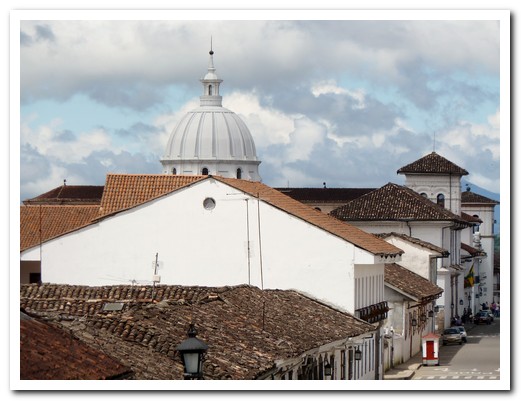
Dome of the Cathedral
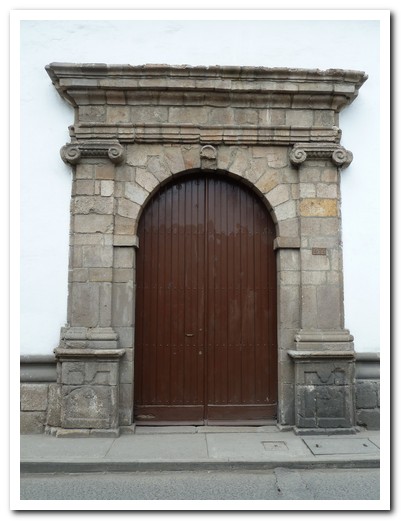
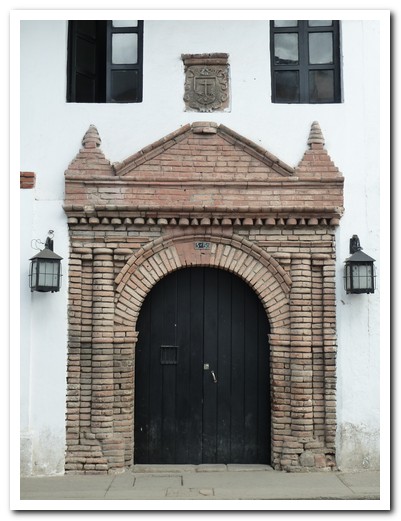
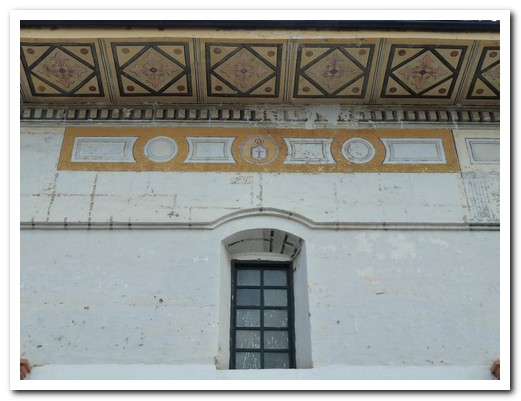
Painted eave of another church
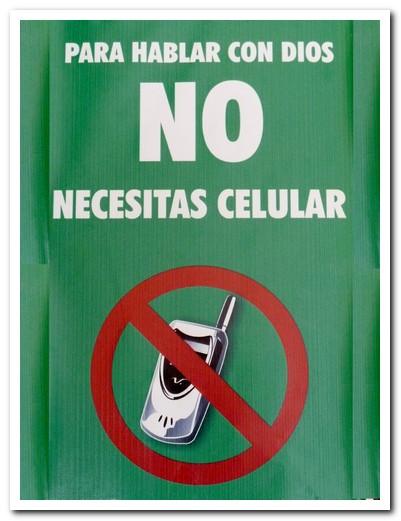
In the Cathedral - ¨To talk to God you don´t need a mobile phone¨
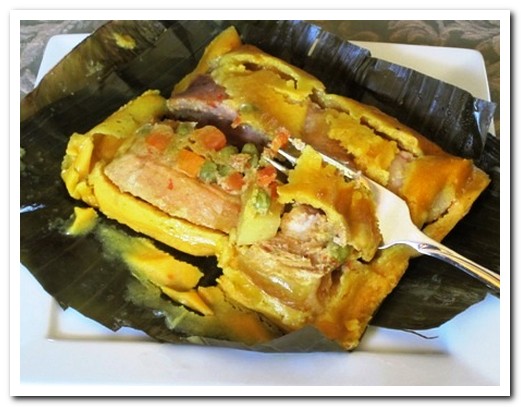
Tamale
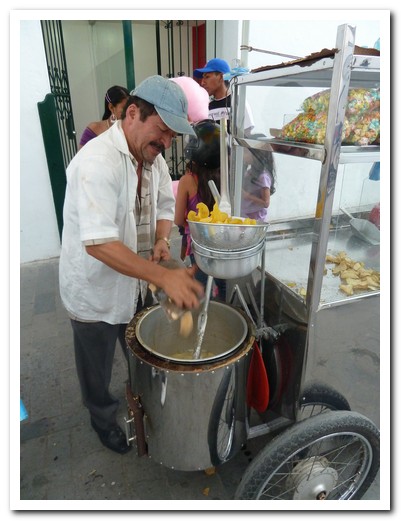
Street vendor making banana chips - yum!
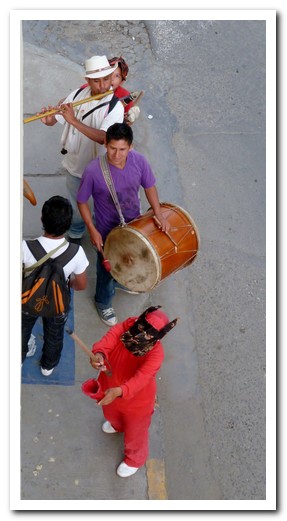
Devil dancing in the street
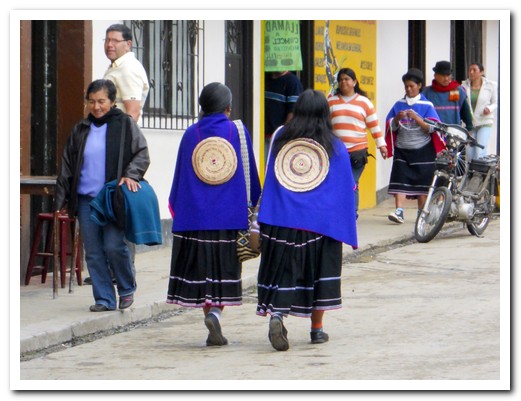
Local women heading to the market in Silvia
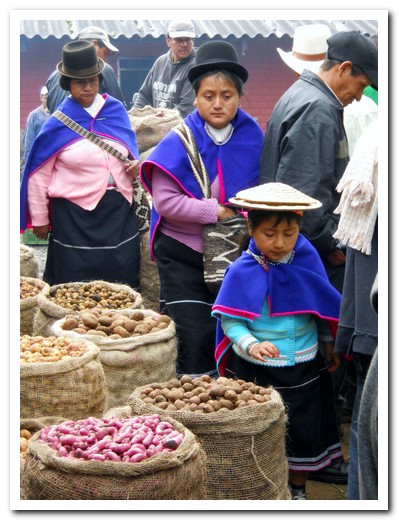
Eyeing off the potatoes in Silvia´s market
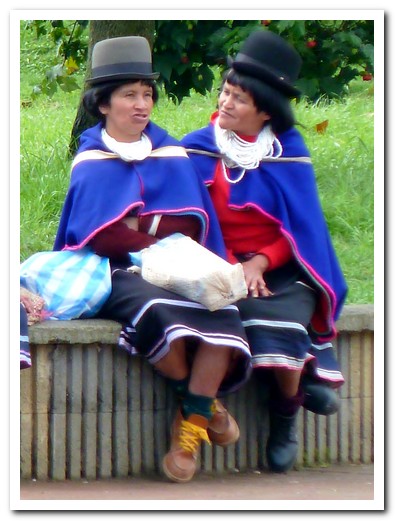
2 ladies chatting

Local man in traditional dress
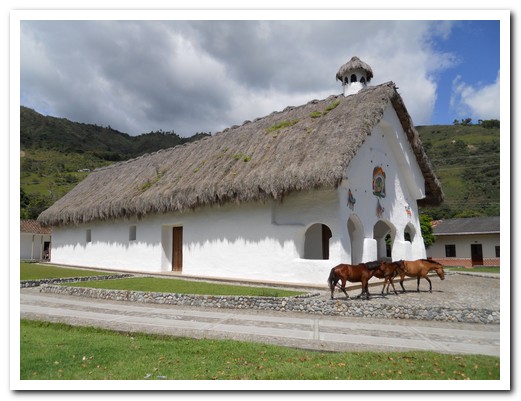
Thatched roof church at San Andrés
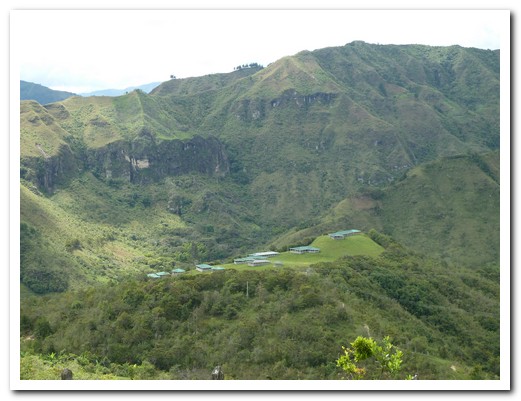
Underground tombs found on a ridge high in the mountains (protected by iron roofs)
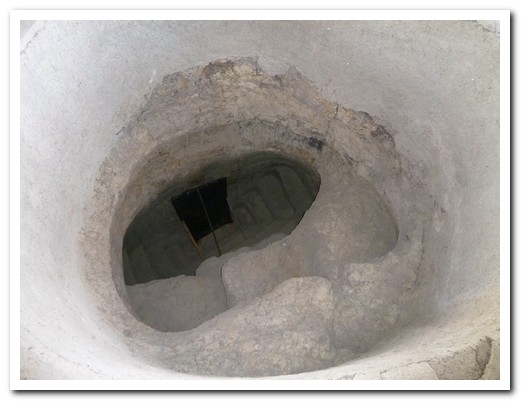
Typical entrance to a tomb, this one original
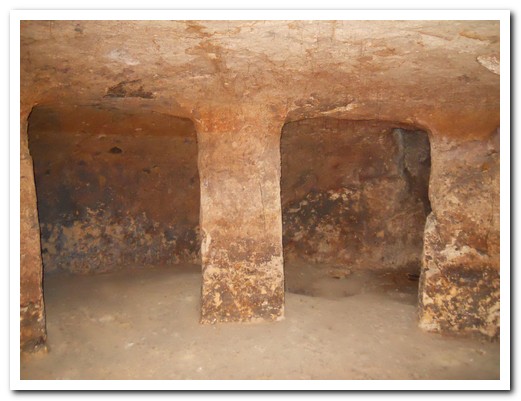
Simple, unpainted tomb
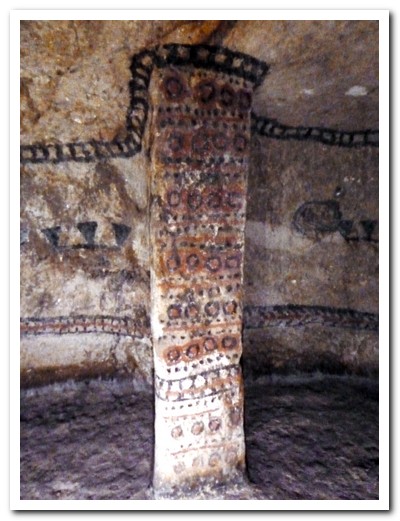
One of the painted tombs
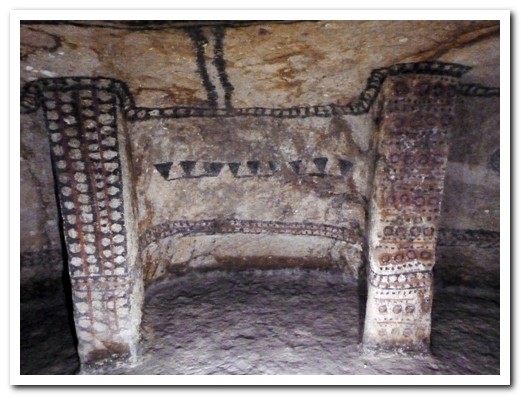
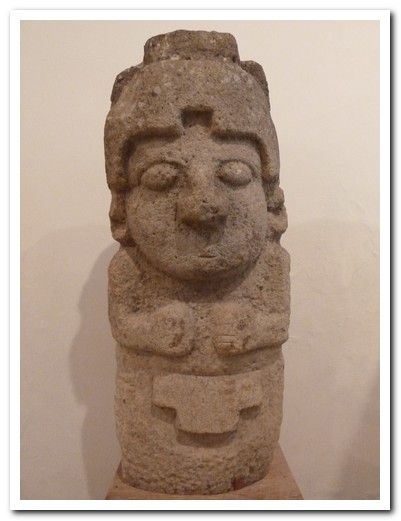
Statue, about 1 meter high
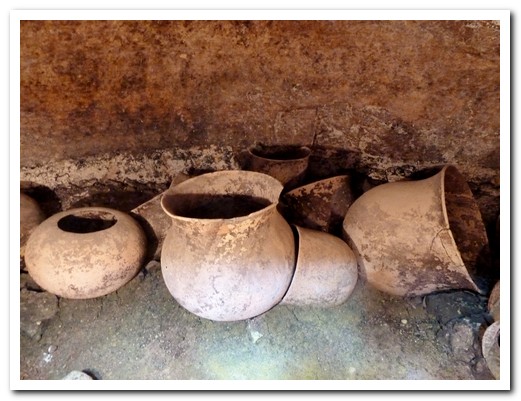
These pots contain cremated human remains
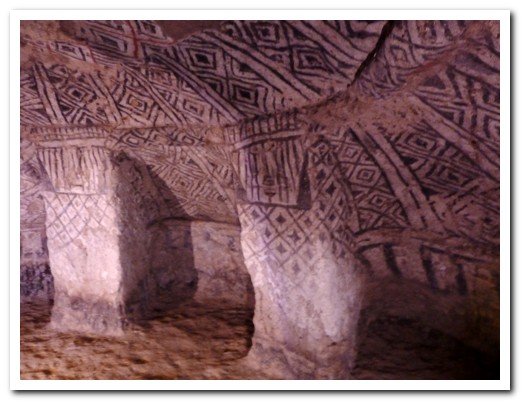
A more elaborate tomb
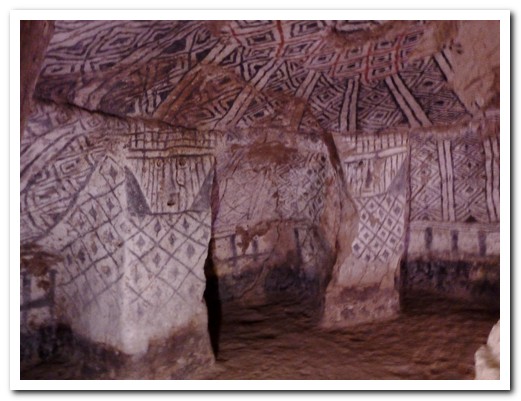
Beautifully decorated ceiling
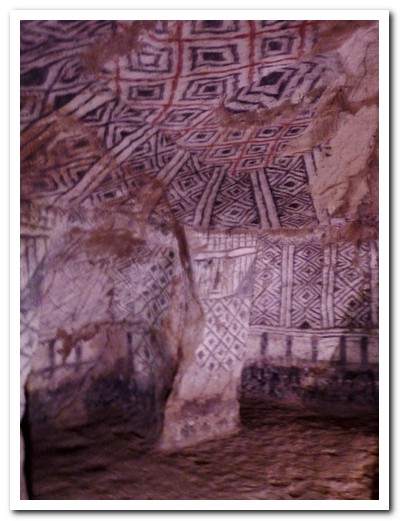
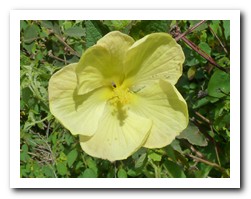
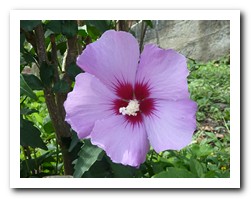
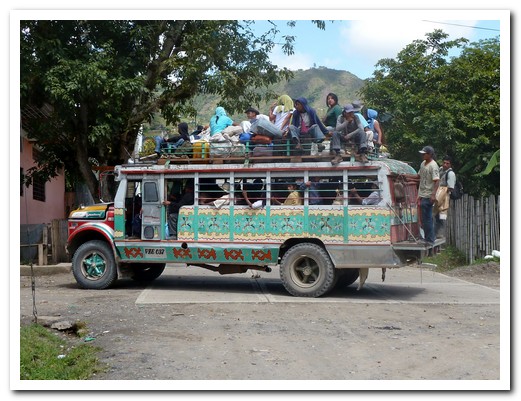
Always room for one more on a chiva!
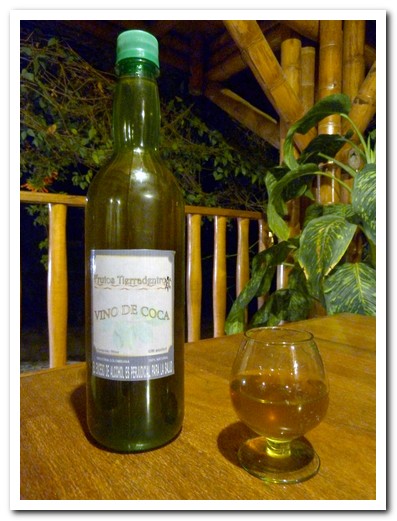
We enjoyed the locally made Coca wine so much we bought a bottle
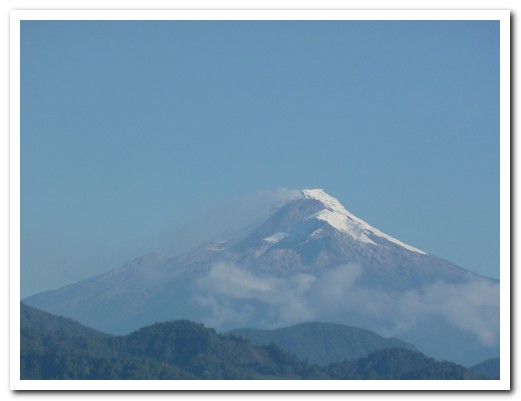
Mountain scenery
San Agustín
25th December 2010
We arrived in San Agustín [9] at 8 am after an all night bus from Bogotá and within minutes Jorge from World Heritage Travel Office had organised 3 days of sightseeing of one of the important archaeological sites in Colombia.
.
The mysterious Agustiniana culture, which thrived between the 6th and 14th centuries around San Agustín, had already disappeared before the Spanish arrival. Inside flat topped burial mounds they left behind tombs with magnificent carved stone sculptures in the shapes of animals, warriors and human faces some mythical, some realistic. There are about 400 statues and tombs scattered in groups in the area. The statues range from less than a 1 meter to 7 meters high, and some were originally brightly painted in red, yellow and black. At the entrance to several tombs there is a carved figure of the deceased flanked by 2 guards. After some time the bones were removed and placed in urns for a secondary, deeper burial. Only tribal chiefs, shamans and priests were buried in this way.
.
On a jeep trip to some of the more remote sites, we passed small farms of sugar cane, bananas and coffee. It was most interesting watching the cane being crushed by hand and the juice being boiled to make blocks of solid raw sugar called panela which is used throughout Colombia as a sweetener.
.
The main sites we covered on foot over 2 days, walking through lovely green countryside passing villages, houses and farms. The people of San Agustín and the surrounding areas have to be some of the friendliest we have met in our travels.
.
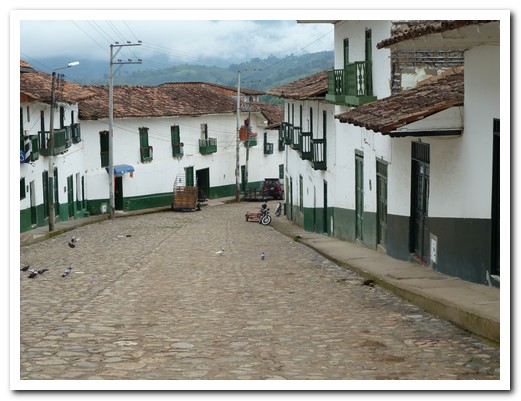
San Agustín´s oldest street
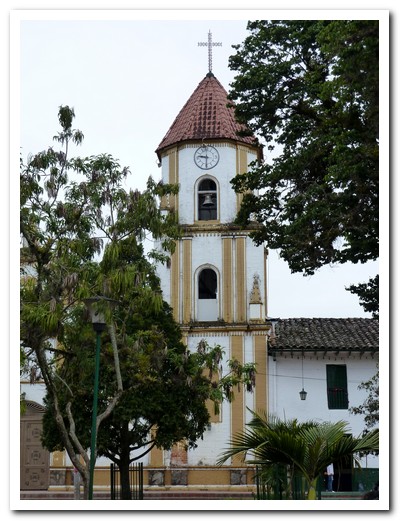
The local church

Santa with some village kids
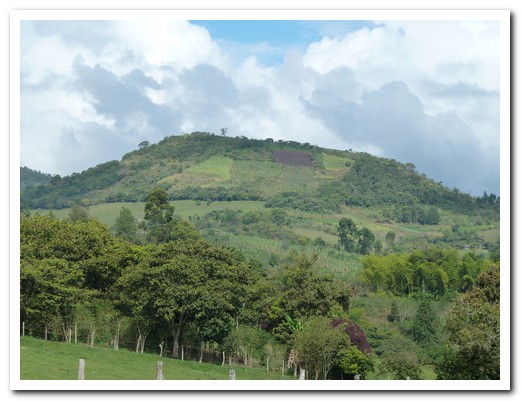
Huge man made burial mound
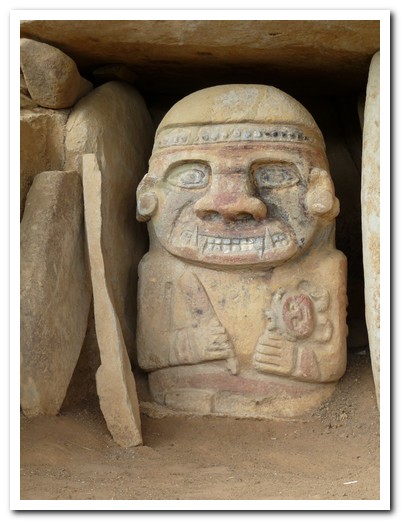
Statue depicting a boy sacrifice
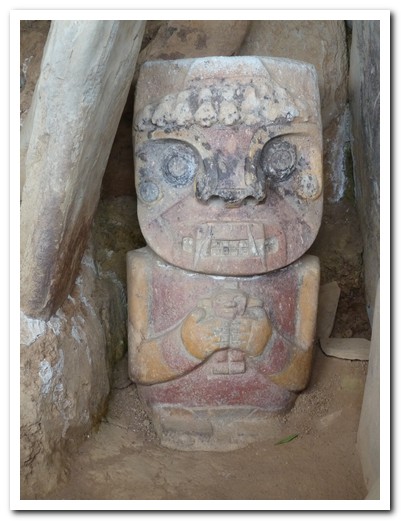
Girl sacrifice (drug induced wide eyes on statue)

Tomb entrance (originally deep under ground)
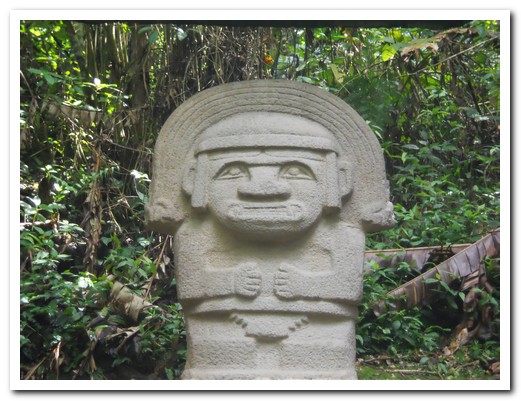
Lone statue in the jungle
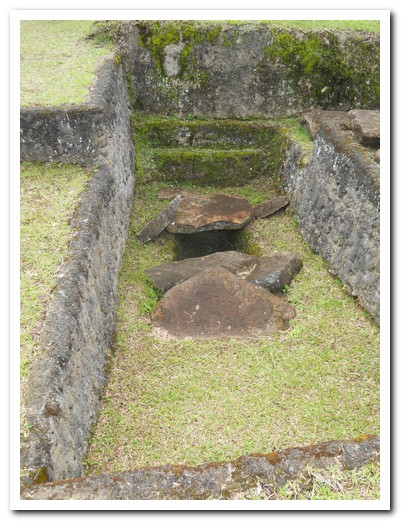
Primary burial tomb
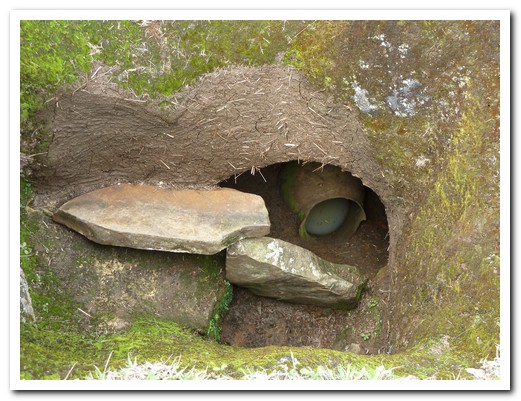
Secondary burial in ceramic pot
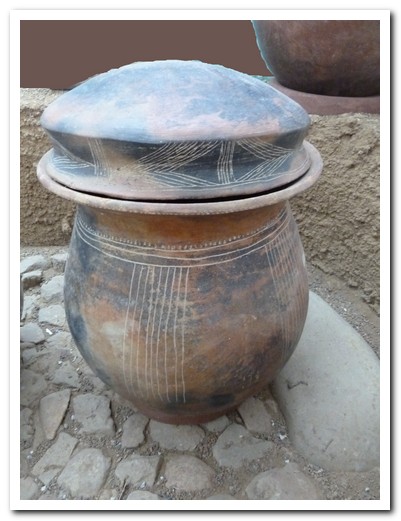
Funeral urn

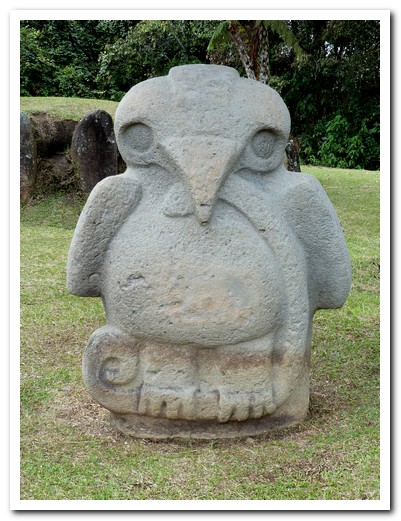
Eagle with snake
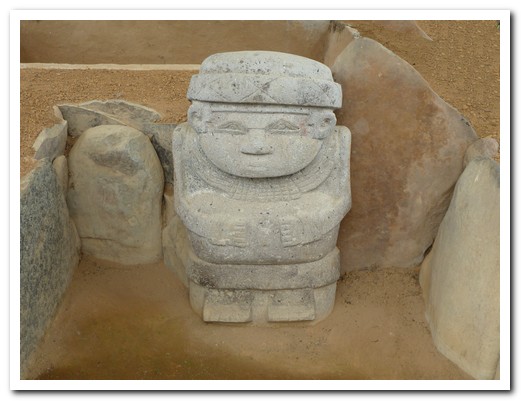
Pregnant woman
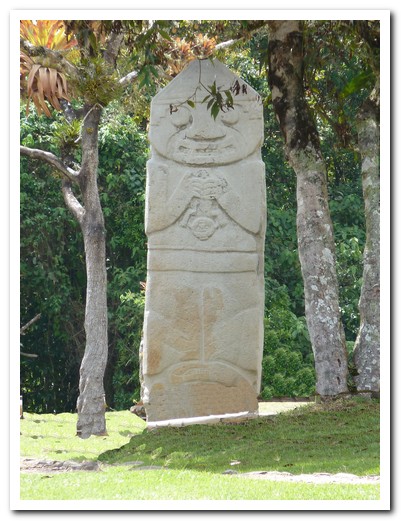
5 meter high statue
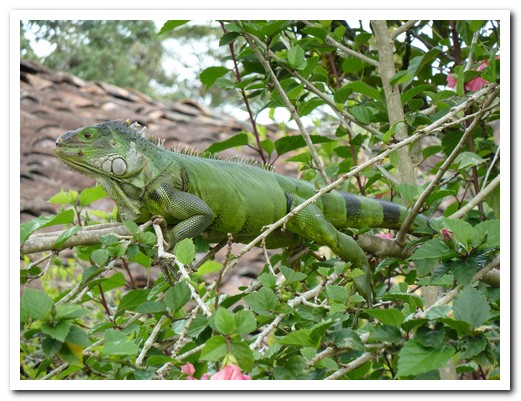
Iguana
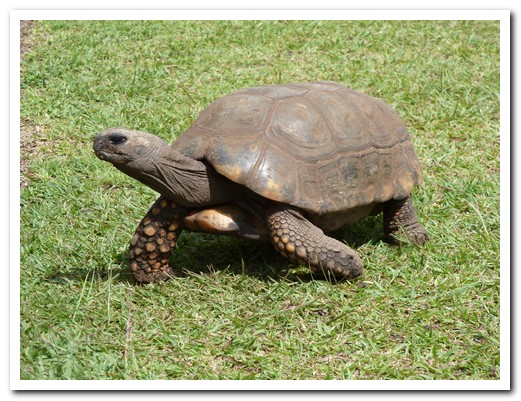
Tortoise
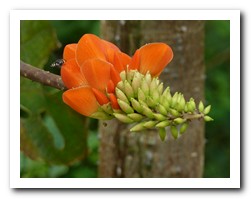 |
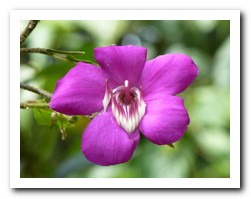 |
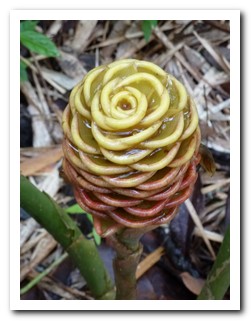 |
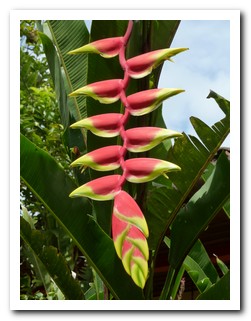 |
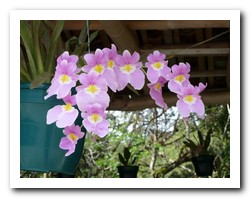 |
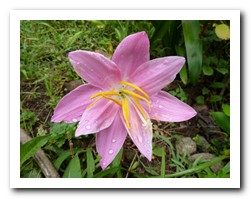 |
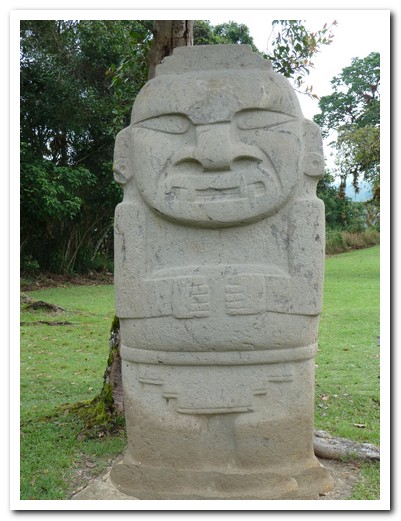
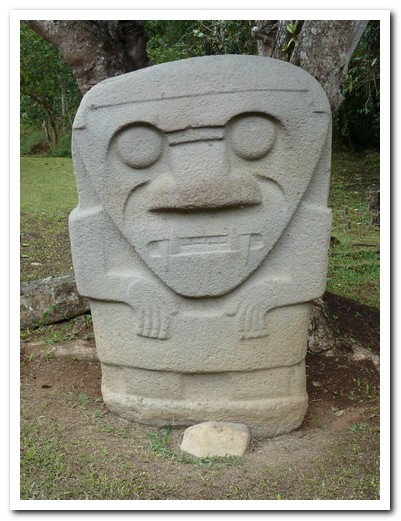
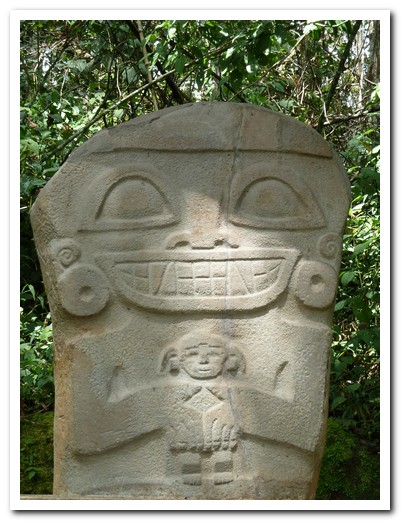
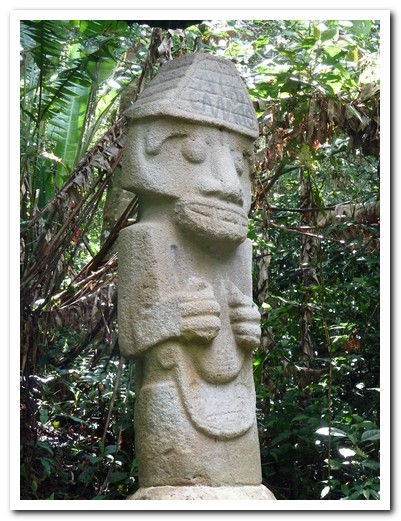
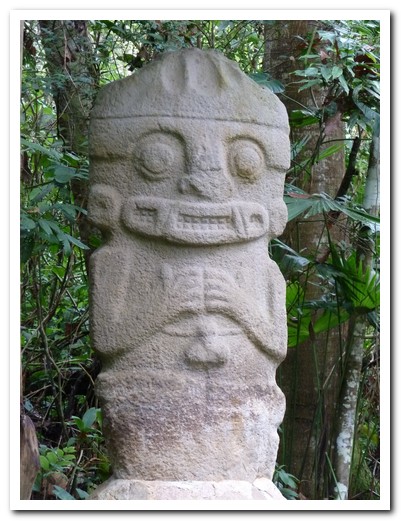
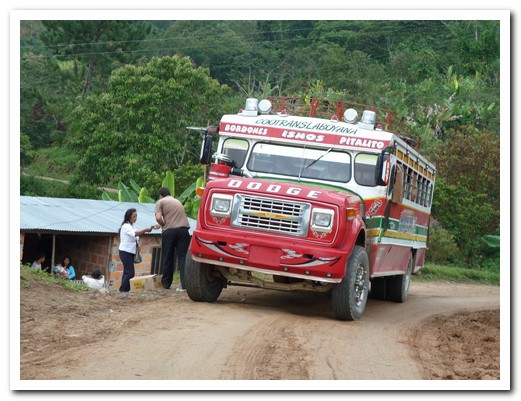
Brightly coloured ¨chiva¨ transports people and goods in the country areas
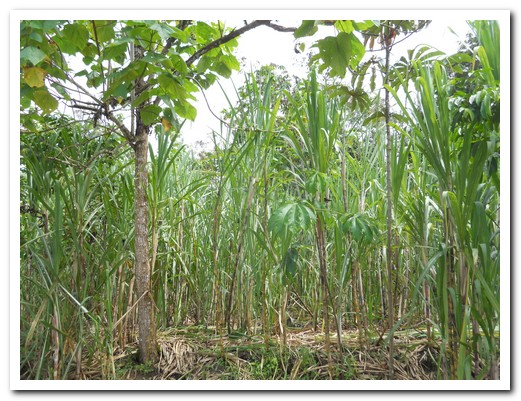
Sugar cane
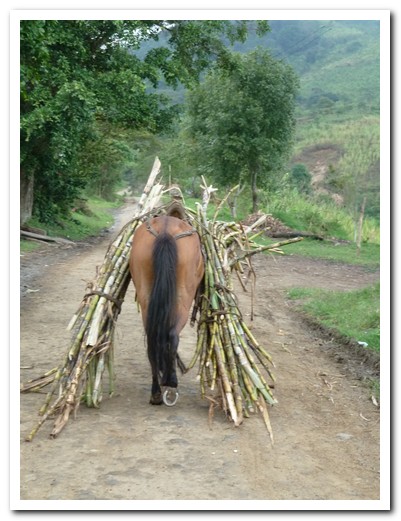
Mules carry the cut cane ...
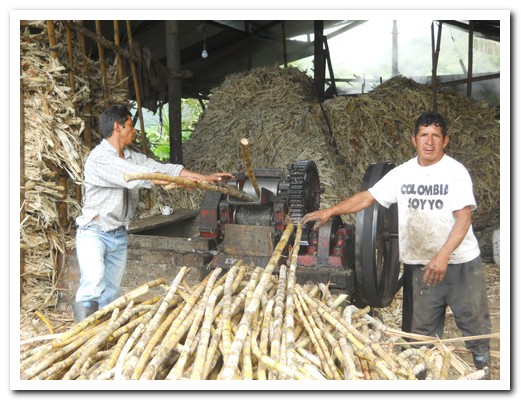
... to the factory for crushing
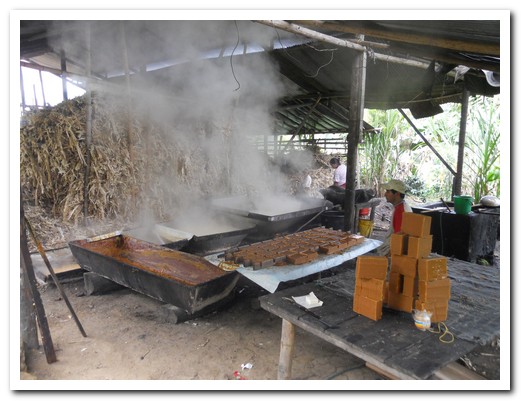
The boiling process to produce blocks of panela
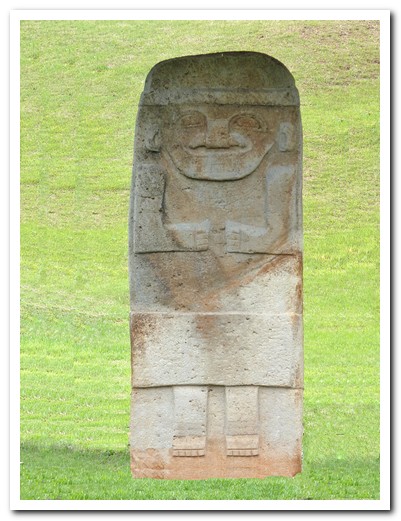
The tallest statue at about 7 meters
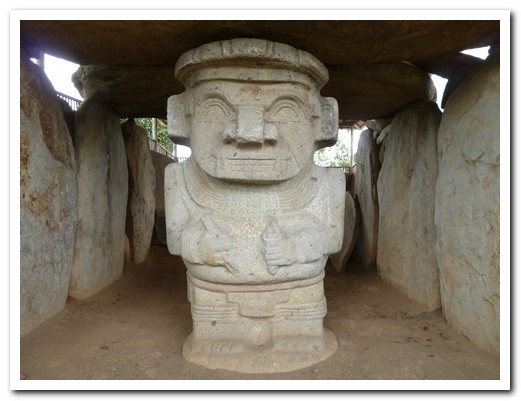
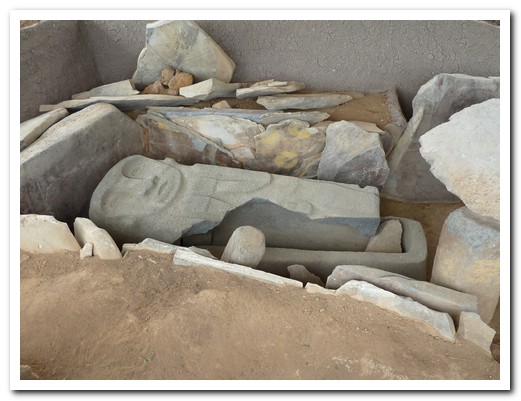
Sarcophagus
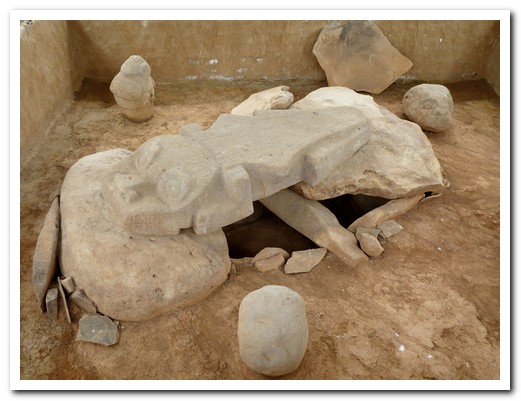
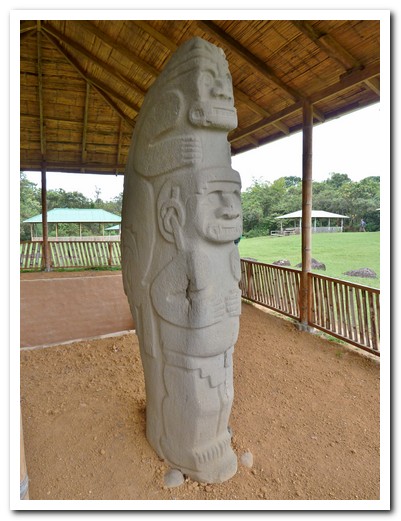
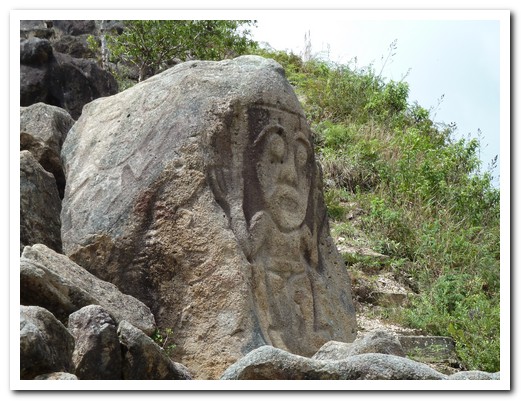
Unfinished statue
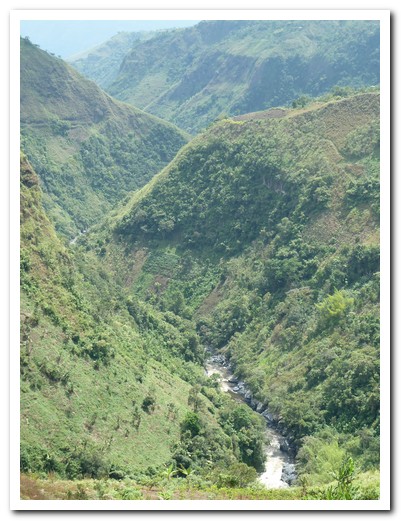
Rio Magdalena divids the east and central Andes of Colombia
Merry Christmas 2010
20th December 2010
.
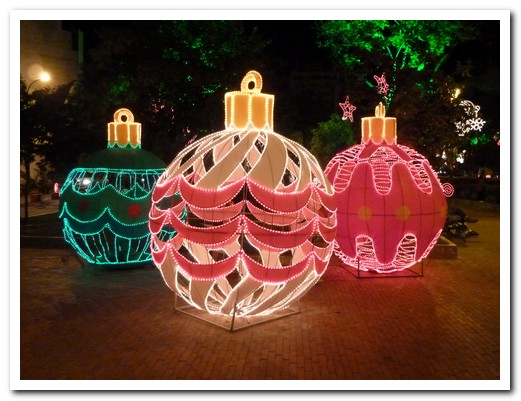
Merry Christmas from Pam and Jeff
in Colombia
Bogotá
20th December 2010
Tired, shabby, traffic snarled Bogotá [7] was a shock after the quiet little colonial villages. Colombia´s capital, founded in 1538 by Spanish explorers, is located on a plateau in the Andes at 2600 meters. It was cold and wet, but the people warm and friendly. From the church atop Cerro Montserrat are wonderful views of the city and surrounding countryside (on a good day).
.
By staying at Casa Platypus in La Candelaria, we were close to the sights of the old centre. We started our walk at the Plaza del Toros, the Mudéjar style red brick bull ring, and continued via many interesting historical churches to the post colonial government buildings. The gold museum, the finest in the world, which displays magnificent gold and pottery artefacts from pre-Hispanic Colombia kept us occupied for a rainy afternoon.
.
On Sunday, we took the steam train to Zipaquirá [8] to visit the Salt Cathedral, the world’s largest underground cathedral which can hold 8400 people, built in a salt mine 180 metres below ground level. The train was slow but musicians playing flutes of the Andes, traditional Colombian music and jazz livened up the trip. When we returned to the Bogotá railway station in the evening, there were no taxis. A kind Colombian family we met on the train, fearing for our safety, offered to drive us back to our hostel. We took up their offer and were very grateful to them.
.
We couldn´t leave Bogotá without trying the local speciality – Lechona, a whole pig carcass stuffed with its own meat, rice and dried peas.
.
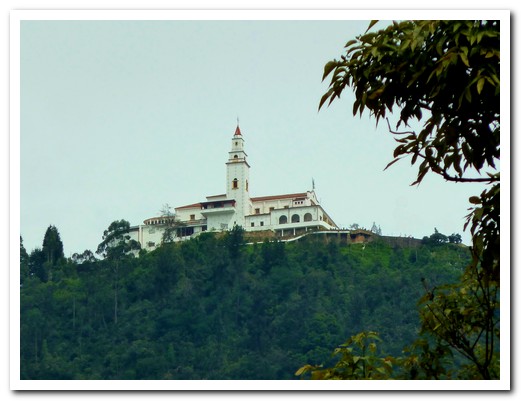
Church on top of Cerro Montserrat overlooks Bogotá
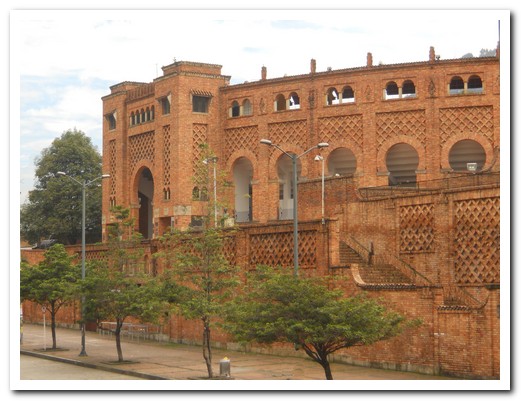
Mudéjar style bullring

One of Bogotá´s 200 churches
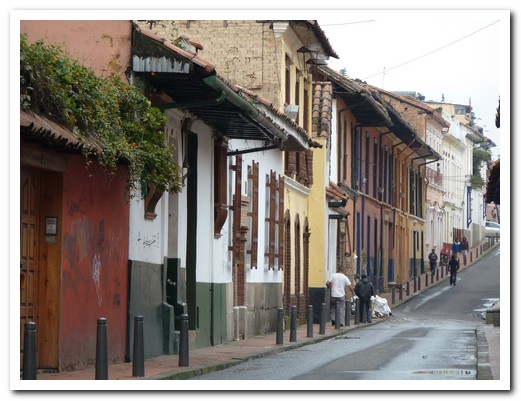
Street in La Candelaria
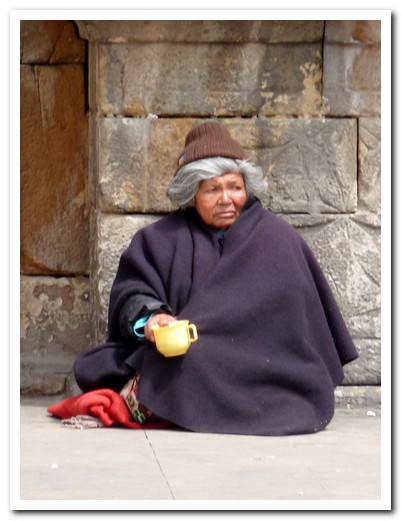
Lady begging
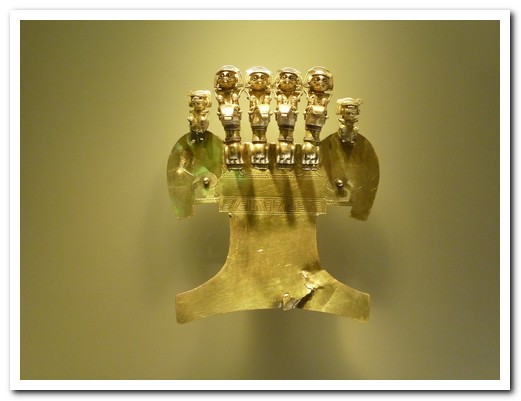
Gold funerary ornamnets ...
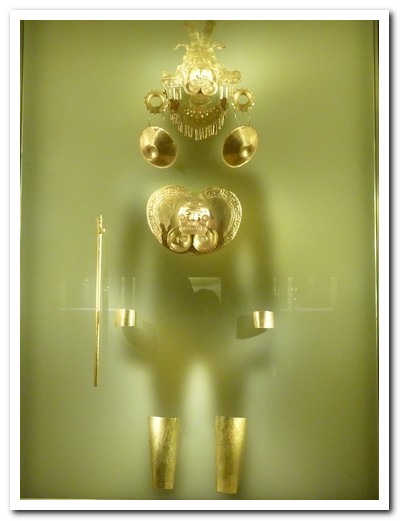
... in Bogotá´s gold museum
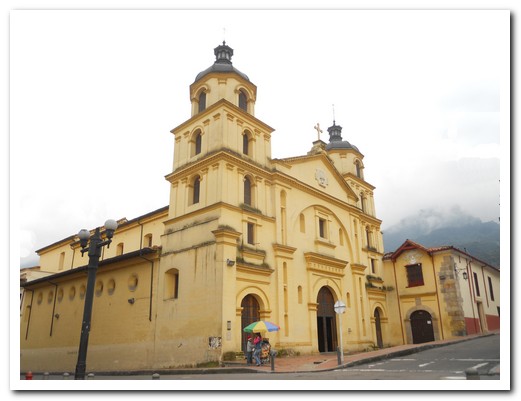
Yellow church
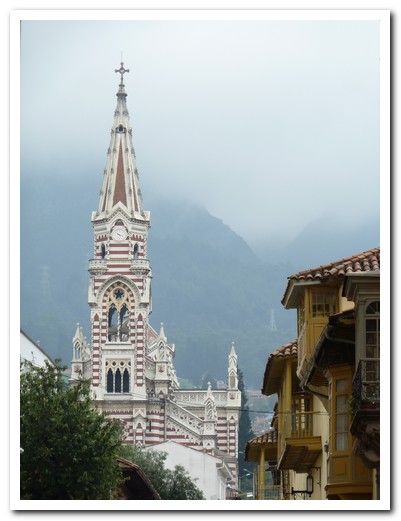
Striped Gothic church
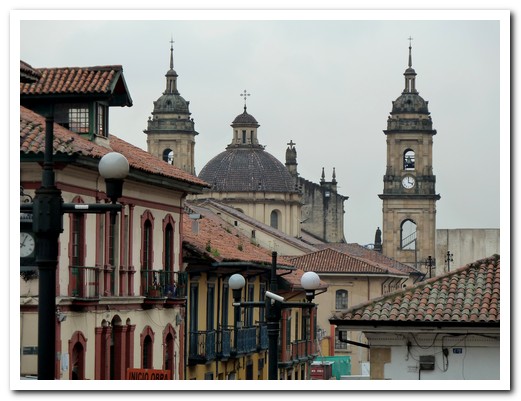
The Cathedral
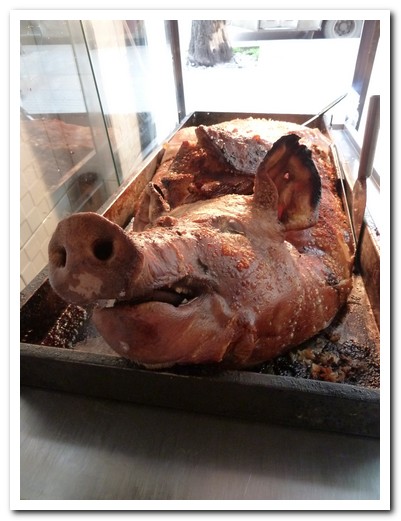
Lechona
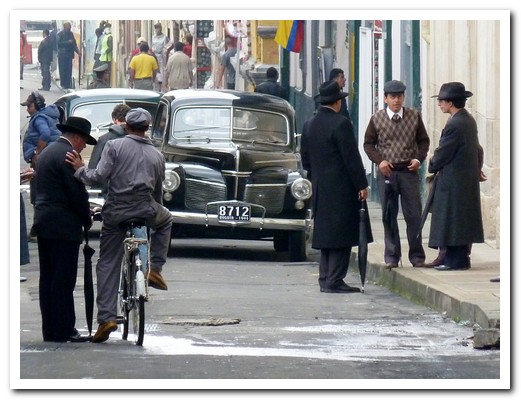
Filming a telenovela (TV soap opera) on a Bogotá street
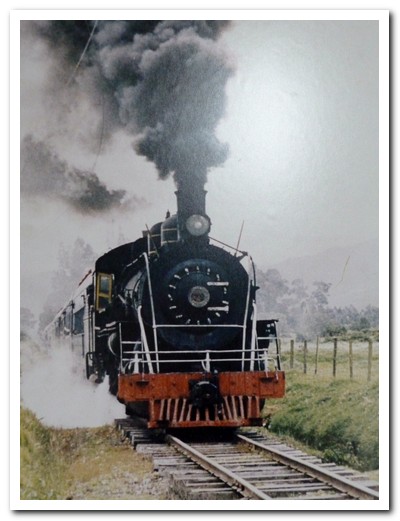
Steam train to Zipaquirá
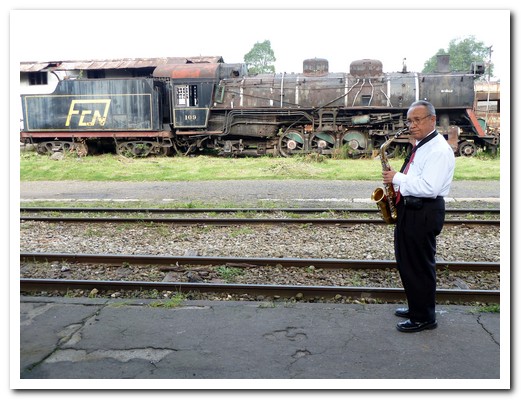
Musicians played
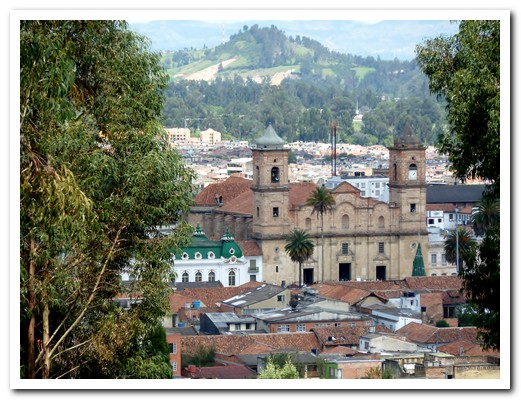
Zipaquirá
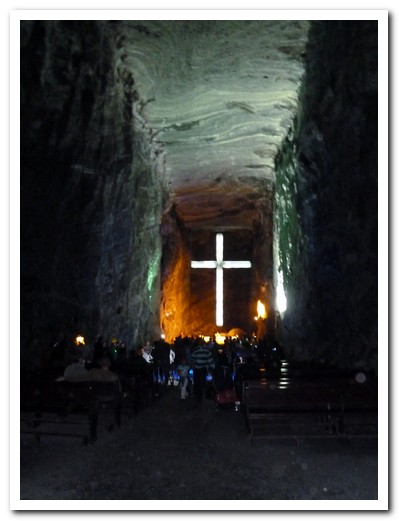
Mass in the Cathedral inside an old salt mine
Colonial Villages
15th December 2010
Leaving the coast behind we headed south to visit some of Colombia´s colonial hill towns.
.
San Juan de Girón[3], founded in 1631, has a central plaza surrounded by blindingly white buildings trimmed with dark wooden doors, windows and balconies. In the evening a religious procession proceeded around the brightly lit plaza which was decorated for Christmas; many families were out enjoying themselves. We watched from the sidelines while sipping a beer from a nearby shop and snacking on grilled corn and meat from a street vendor.
.
The much quieter Barichara (population 7500) [4] has kept its colonial charm. There are no modern buildings. The streets are paved with stone; the whitewashed walls have a splash of colour that matches the doors and windows. A pleasant way to visit the tiny, nearby village of Guane is by foot along the pre-Hispanic Camino Real, a footpath that once joined the indigenous villages. As we walked we enjoyed views of the surrounding mountains whilst listening to the birds and following the butterflies.
.
Tunja [5], lying in a lush green valley at 2800 meters, was an enjoyable stopover. There are some elegant mansions from the Spanish days, a large Plaza and 8 churches built in the Spanish Mudéjar (Islamic influenced) style around the historic centre.
.
A short bus ride away and 700 meters lower is the postcard perfect colonial village of Villa de Leyva [6], founded in 1572. We hired bikes to ride to the fossil of a Kronosaurus (a giant prehistoric croc) and an ancient Muisca people ceremonial site of phallic stones and cylindrical stone monoliths which functioned as a solar observatory. In the surrounding hills is the Convento del Santo Ecce Homo (founded 1620).
.
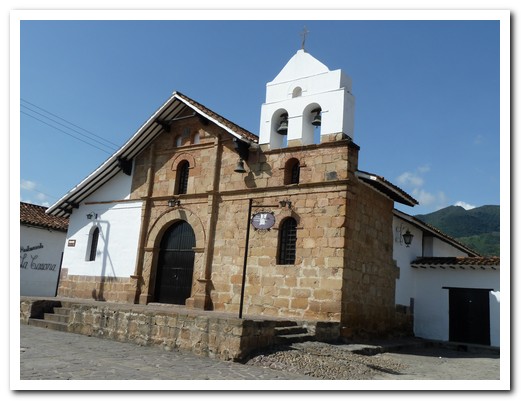
Old church at Girón
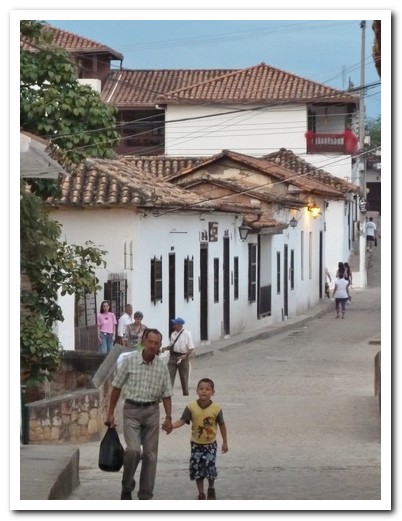
Dazzling white buidings ...

... of Girón
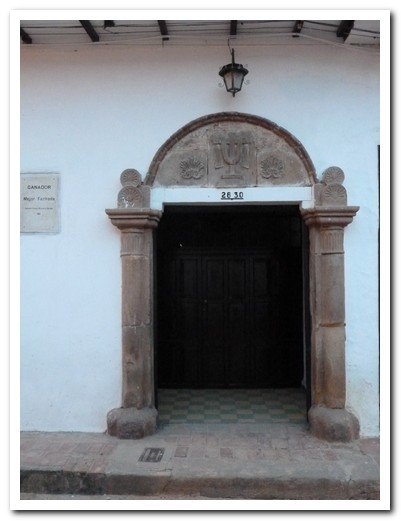
Doorway
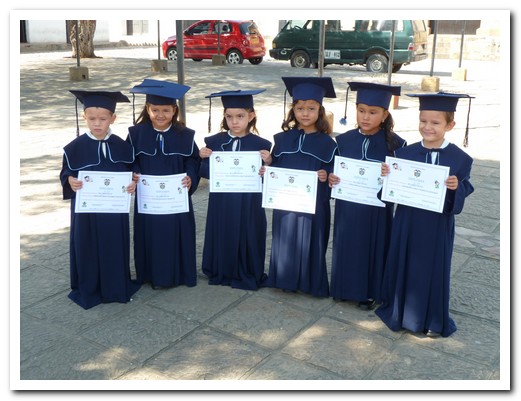
Graduating from kindergarten
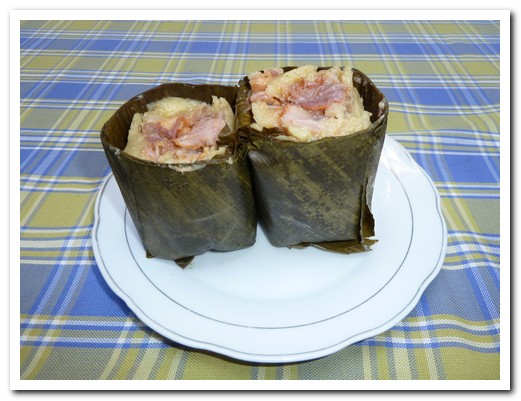
Breakfast tamales
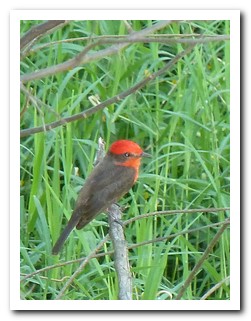
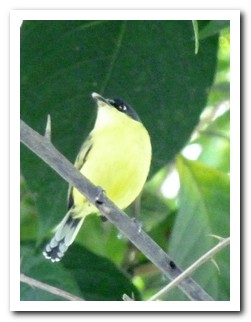
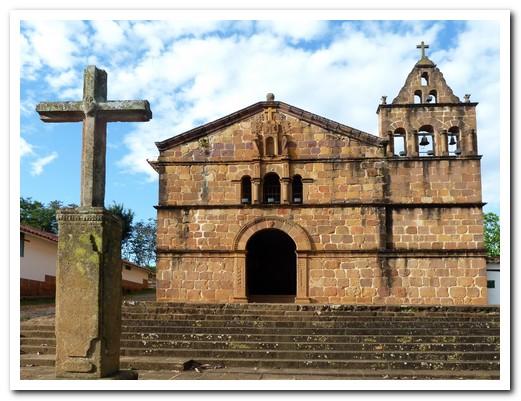
Barichara Church
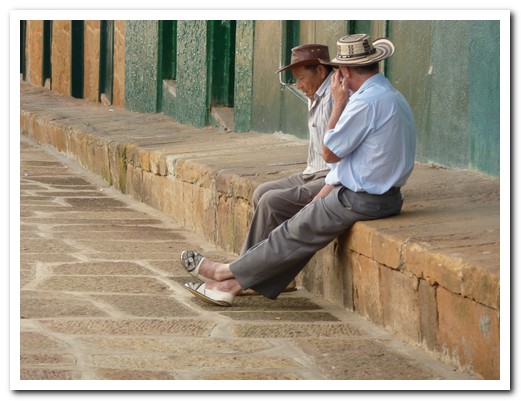
Typical hats and slippers of this region
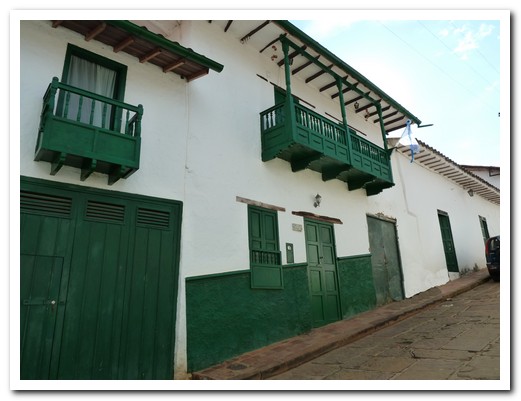
Houses in Barichara
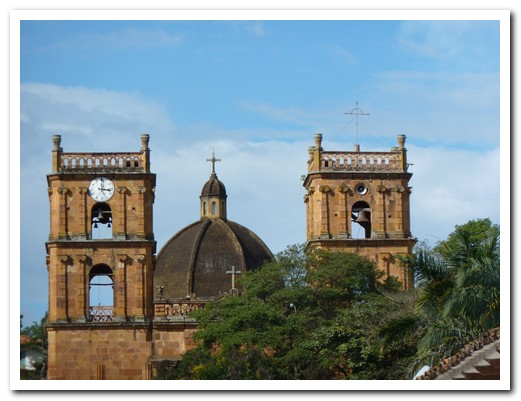
Barichara Cathedral
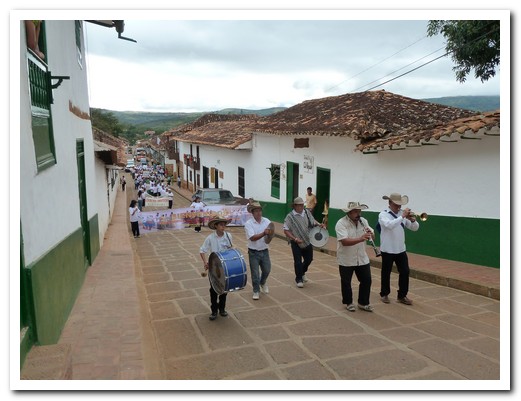
Barichara´s senior citizens march up the hill (followed by ambulance)
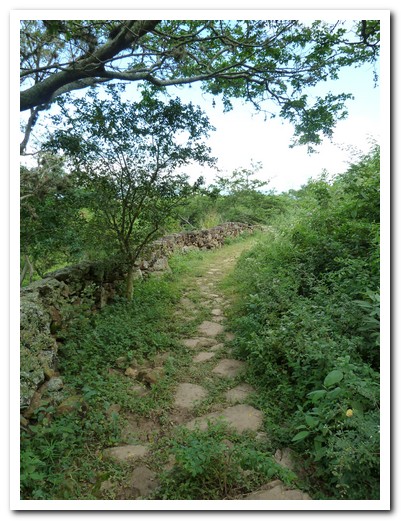
Camino Real
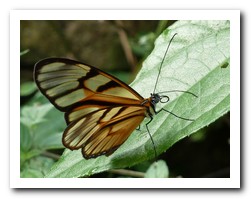 |
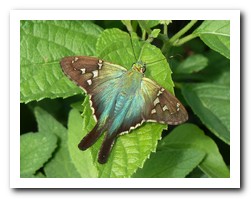 |
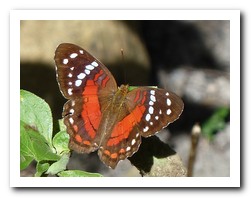 |
 |
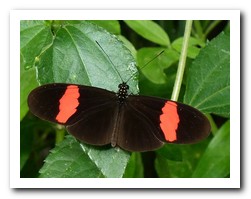 |
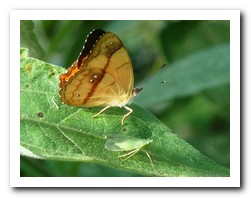 |
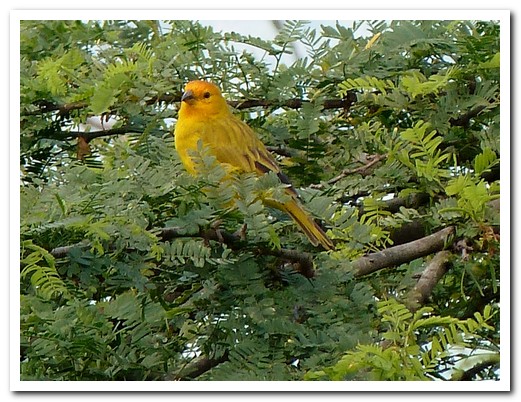
Bird singing on Camino Real
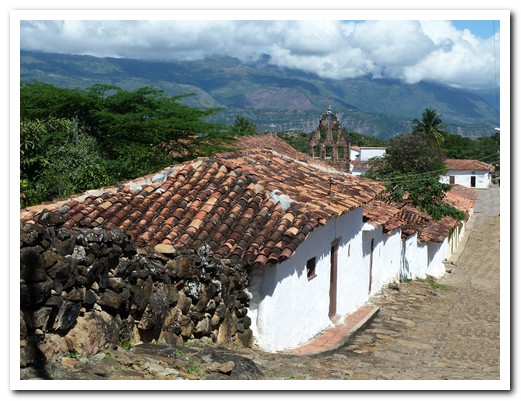
The village of Guane
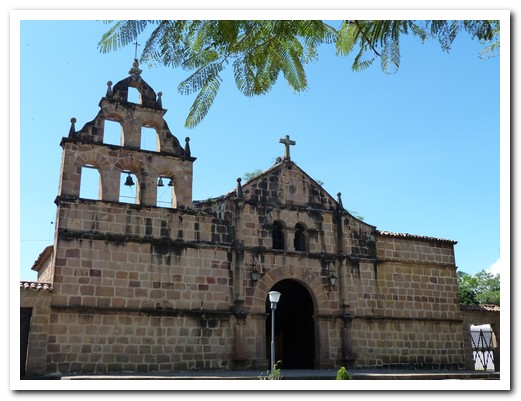
Guane Church
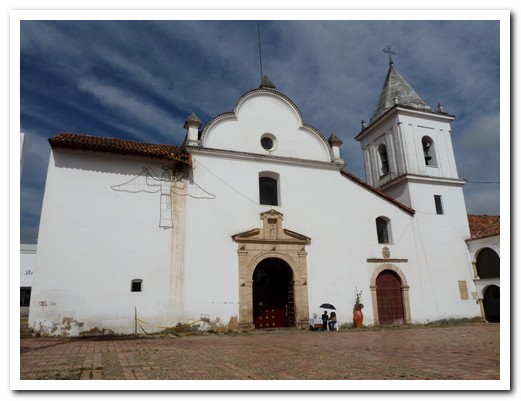
One of Tunja´s churches in the Mudéjar style

Doorway
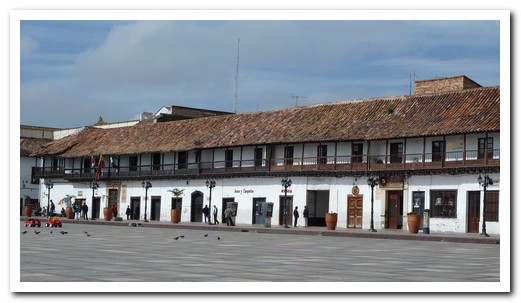
Plaza Bolivar - Tunja
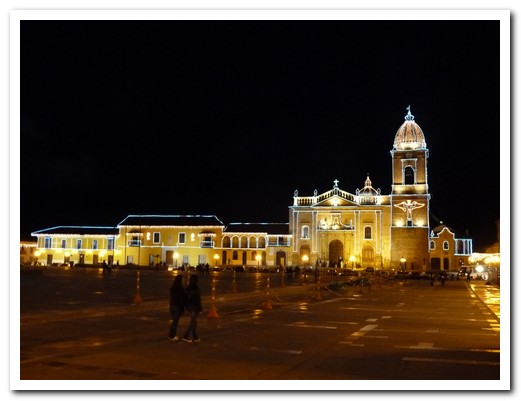
Plaza Bolivar and the Cathedral by night
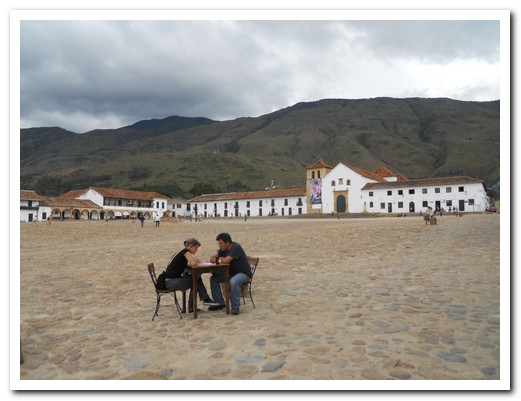
Plaza (largest in South America) at Villa de Leyva
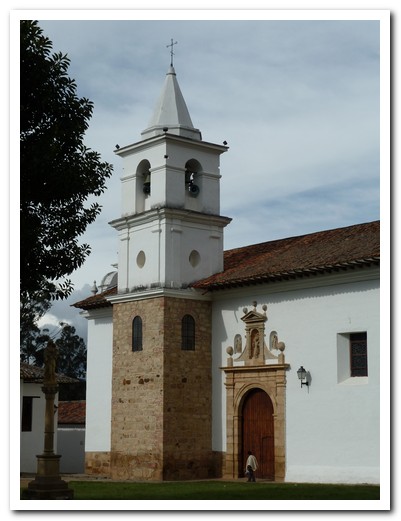
Carmelite monastery at Villa de Leyva
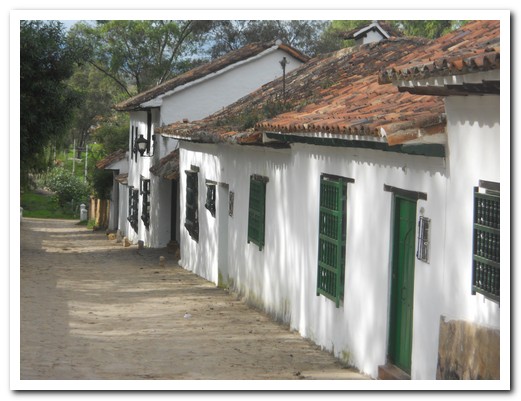
Shady street

Typical mens dress
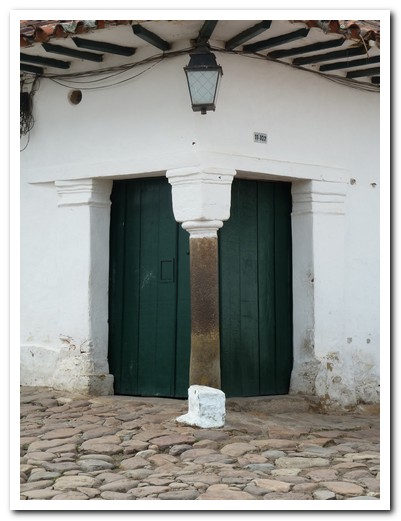
Corner of a Villa de Leyva buiding (note paving and no footpaths)
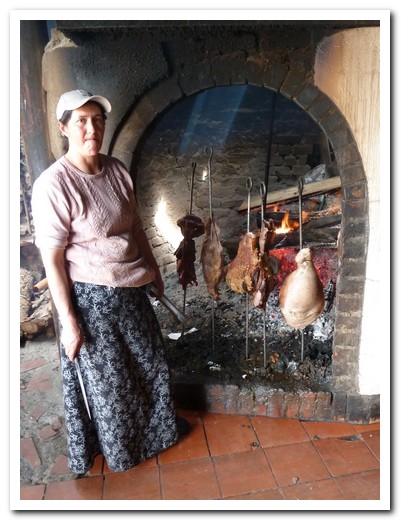
Lunch of meat grilled on an open fire
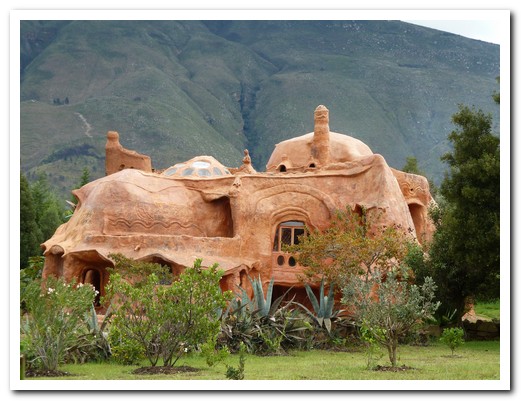
Nearby is a house made from clay, Gaudi style
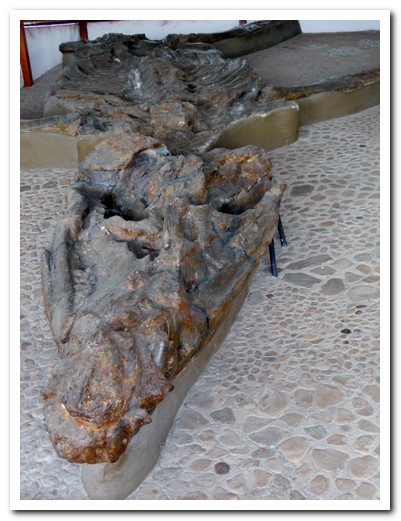
Fossil of a 7 meter Kronosaurus
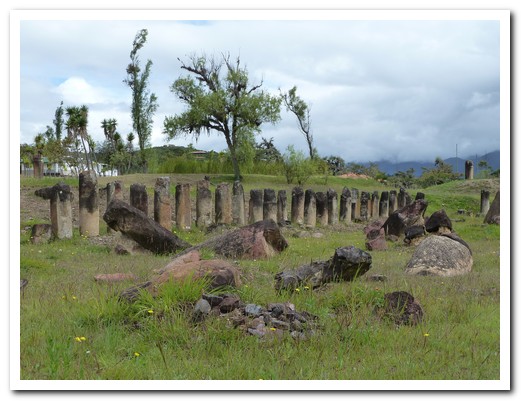
Stone monoliths arranged to follow the sun´s path
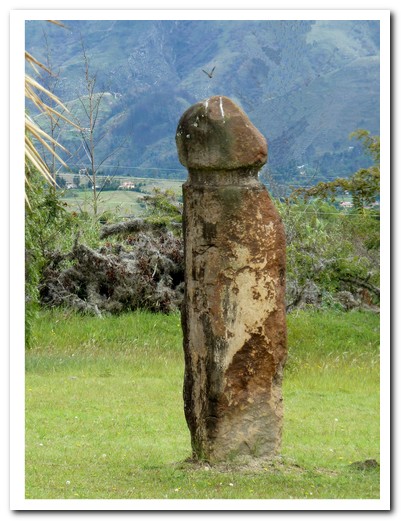
Many huge phallic monoliths are still standing
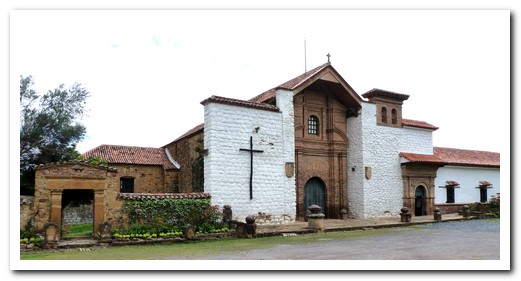
The 1620 Dominican Convento del Santo Ecce Homo
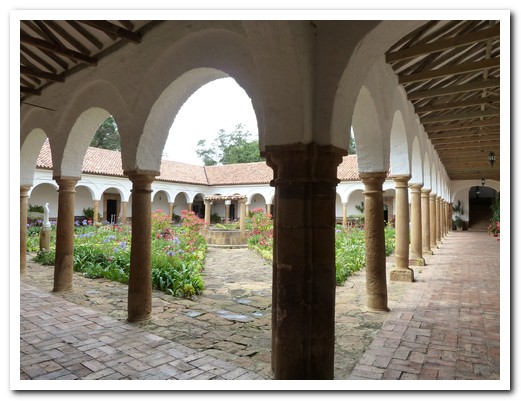
Inside the Convento
The Lost City
04th December 2010
Our first stop in Colombia was the pleasant Santa Marta [2] on the Caribbean coast of Columbia and the oldest city in South America. A drawn out 24 hours from Mérida (Venezuela) featured a bus full of suspicious people openly bribing officials at all 12 check points between Maracaibo [1] and the frontera. Something must have been up as Colombian police grabbed them soon after crossing; thankfully we had already changed buses.
.
The next day we spent relaxing at the beach in the nearby fishing village of Taganga where we chose a fresh reef fish for lunch from one of the palm thatched restaurants along the beach. Perfectly cooked, it was delicious.
.
To begin the tough trek through the Colombian jungle to the Ciudad Perdida (Lost City) a four wheel drive took us to the pueblo of El Mamey on a barely passable, rutted, muddy track. The first creek crossing, with knee deep water, came up after 5 minutes walking. It was no use being precious, there were many more creek crossings and a lot of mud to come so we barged straight through, boots and all. The gradient increased seriously (Kokoda Track style) before a steep, muddy descent to our first nights camp which was a row of hammocks strung up under a shelter. It rained every day so the same set of wet clothes and boots went back on in the mornings and at night a carefully kept dry set.
.
It continued to rain day and night but what´s a rainforest without rain. The trail was difficult at times but the scenery superb. We encountered scattered huts of the Kogui tribe (descendants of those from the Lost City) and passed the indigenous residents going up and down the trail. They all wear the same white(ish) tunic made of a natural fibre from the jungle and both men and women have long hair. There are some 1400 living in the Tyrona National Park.
.
Two of the river crossings on day two were a little unnerving – one by sitting in a little open cage and being pulled across, 20 metres above the raging water, the other by wading through waist deep water, holding on to a rope strung across the river. With 3 strong men supporting us across, our feet were still swept from under us half way across and we had to be dragged the rest of the way. On day 3 it rained heavily for 12 hours and we nervously watched the river rising rapidly. The next morning we had to make 3 more crossings. The force of the water was just too powerful; poor John (one of our guides) carried us on his back while struggling with the rope.
.
More than 1200 mossy stone steps wind their way from the river up the jungle covered mountain to 1100 metres where the Tyrona Indians lived from 800 to 1600. After it was abandoned, the city was soon reclaimed by the jungle until in1972, was re discovered by grave robbers looking for gold. The dwellings are no longer there but elaborate terraces still stand where each dwelling was. Wide stone paths lead to the large ceremonial and central plazas.
.
We returned the same way; it had rained all night so the path was a river or a muddy quagmire. The 4 wheel drive road had deteriorated. Our vehicle stalled crossing a swollen creek and water poured in through the doors. The vehicle behind towed us out and we had to wait 2 hours for the water to subside finally reaching Santa Marta at 9pm.
.
The trek was fantastic and the Lost City worth all the effort but enough Indiana Jones stuff for us for a while.
.
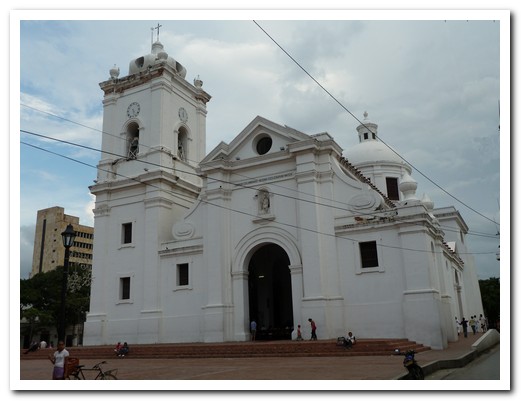
Santa Marta church
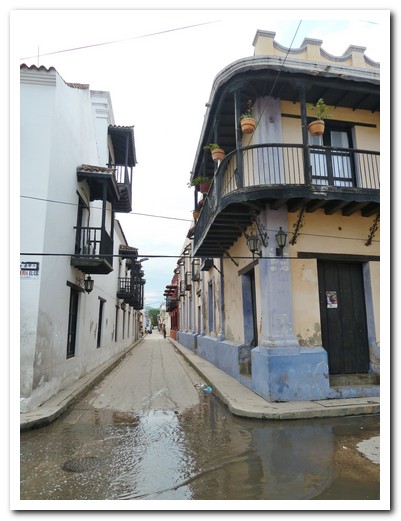
Colonial buildings in Santa Marta
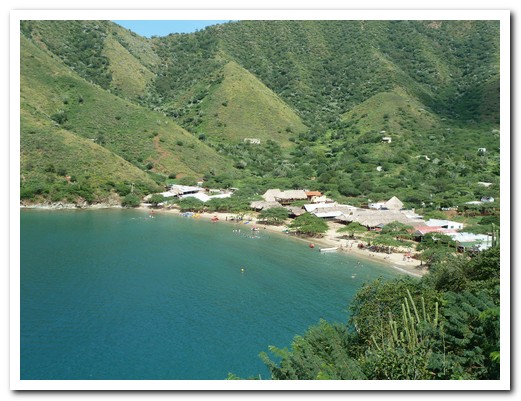
Nearby Taganga
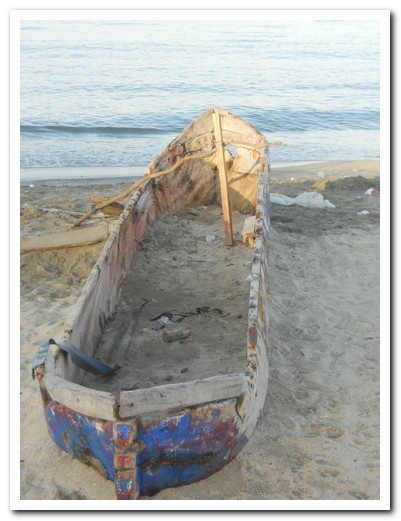
Canoe on the beach
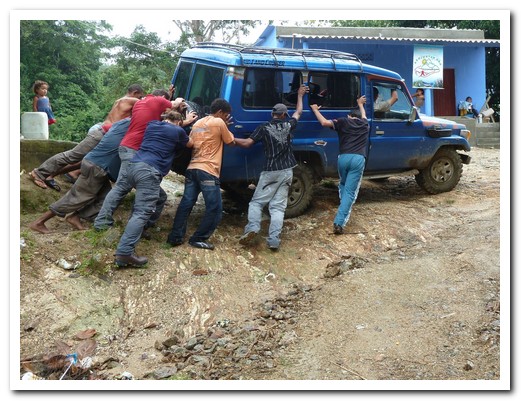
Colombian starter motor on the way to the Lost City trek
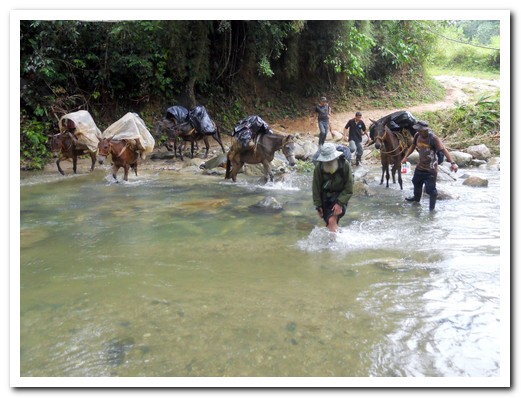
Look out - here come the mules
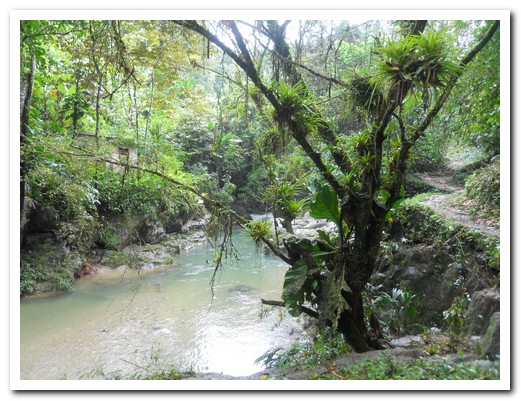
Jungle path
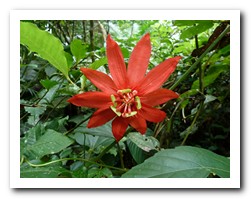
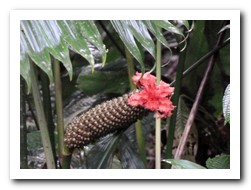
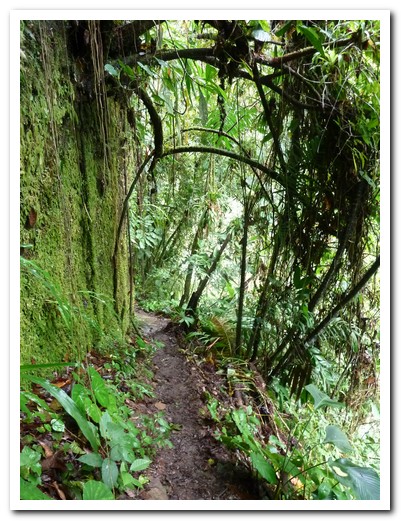
More jungle path

Camp 1
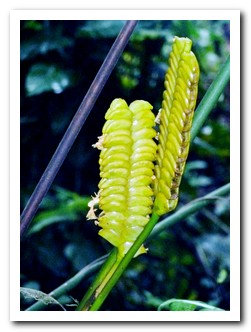
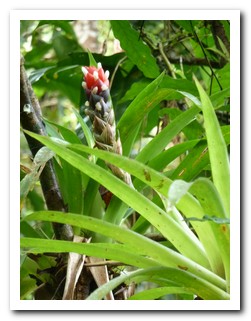

Indigenous huts
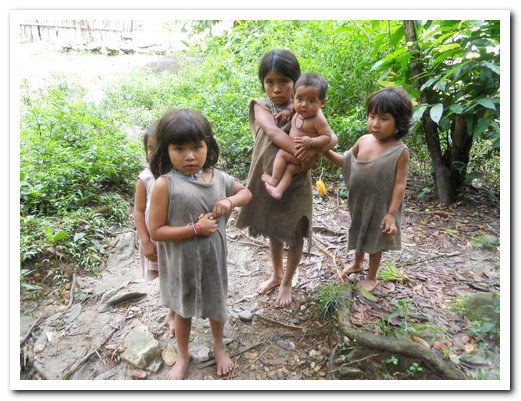
Some of the children
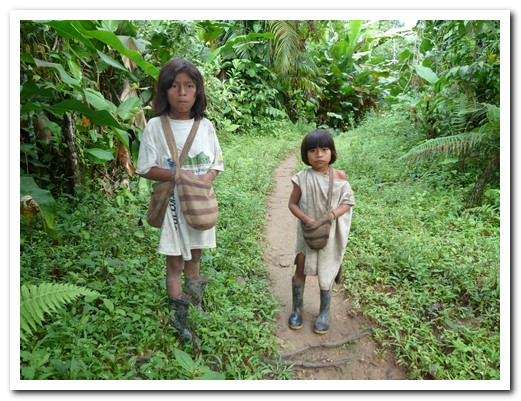
Children with typical carry bags
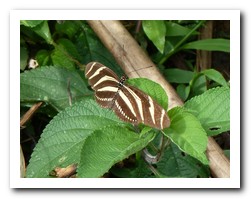
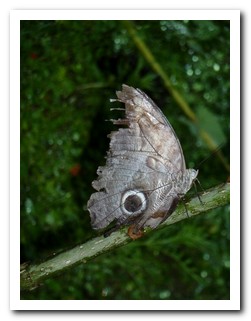
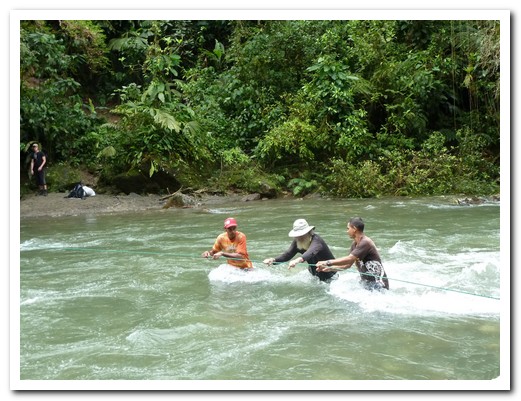
This is one way to cross a river
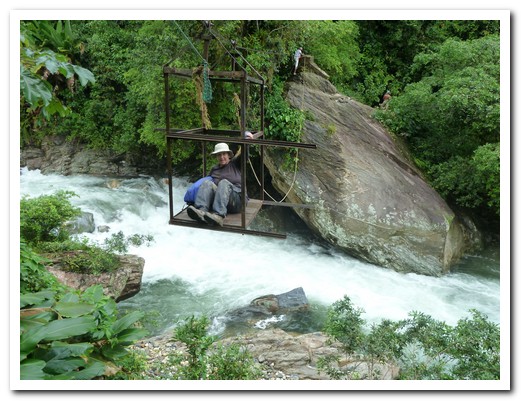
Another way to cross
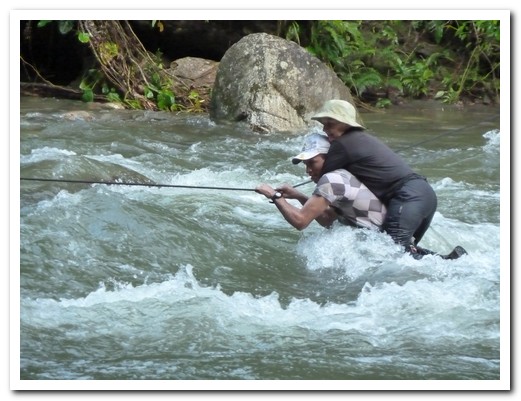
And when all else fails ...
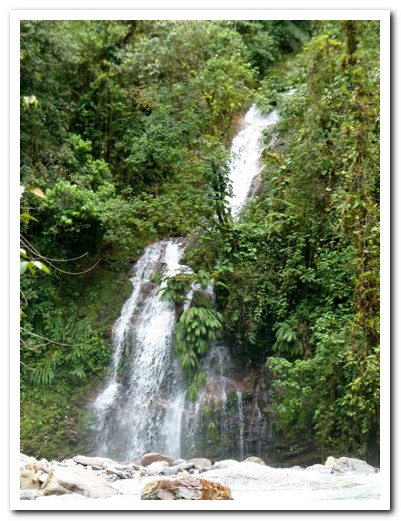
Waterfall
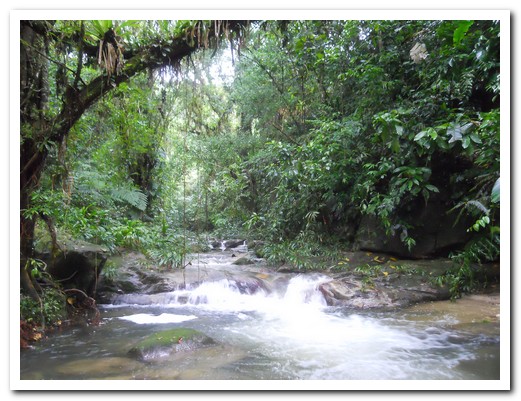
Path turned into a river after the rain
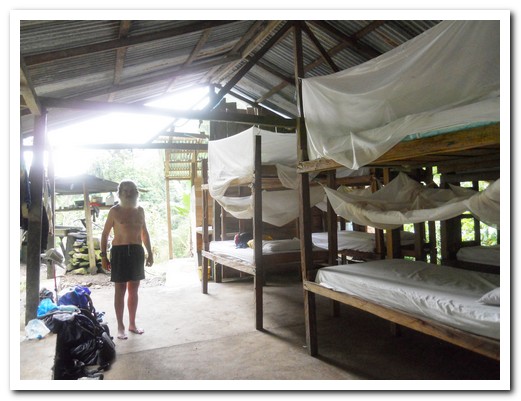
Camp 2
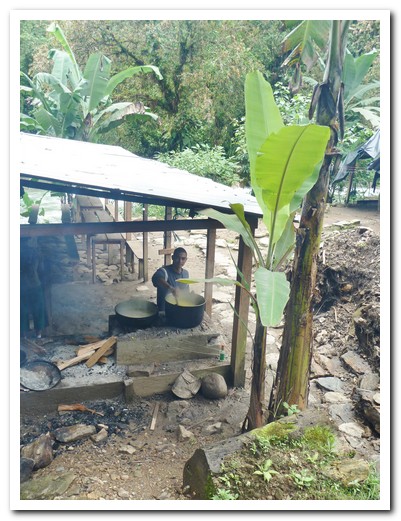
Freddie made delicious soup over a wood fire
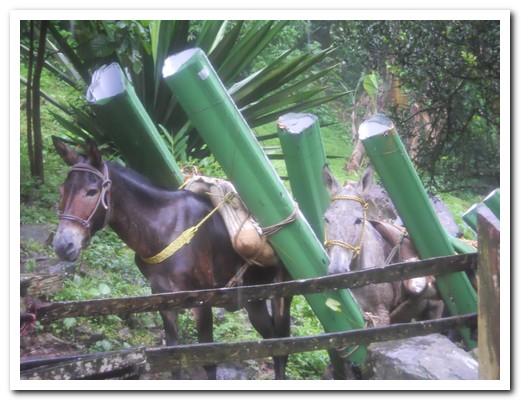
Mules carry tin roofing up the trail
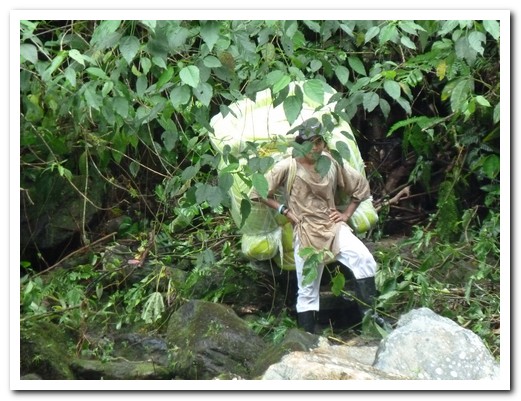
This is how the matresses get there
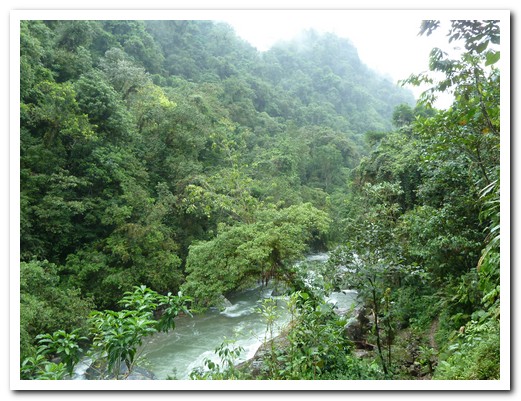
Swollen river
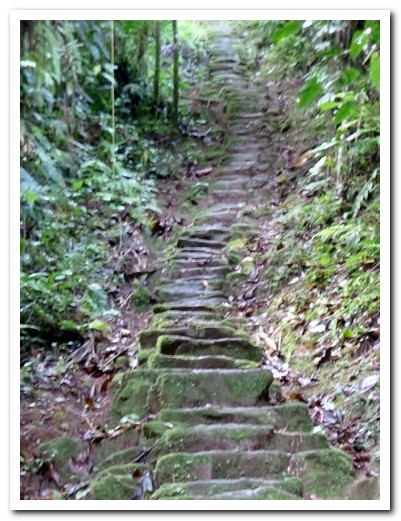
Mossy stone steps winding up to the Lost City
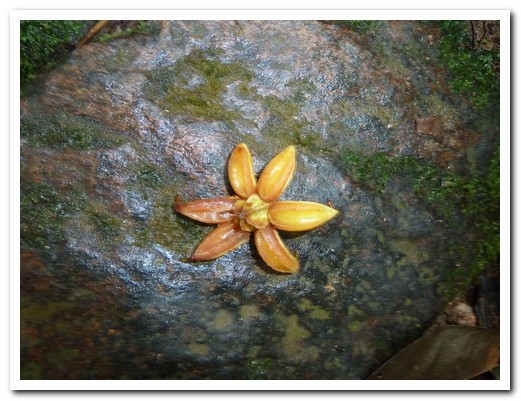
Flower on one of the steps
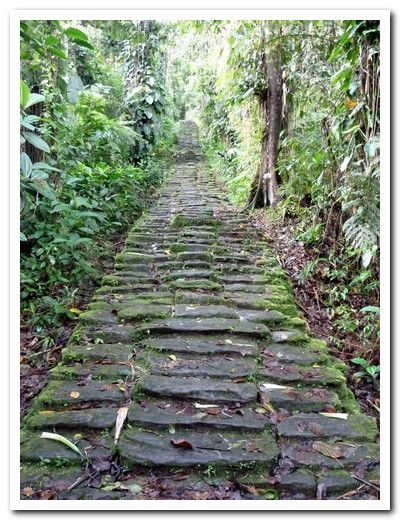
Long even steps lead to ...
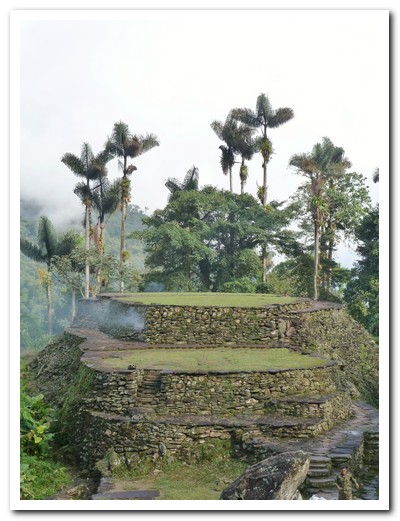
... The Lost City central plaza
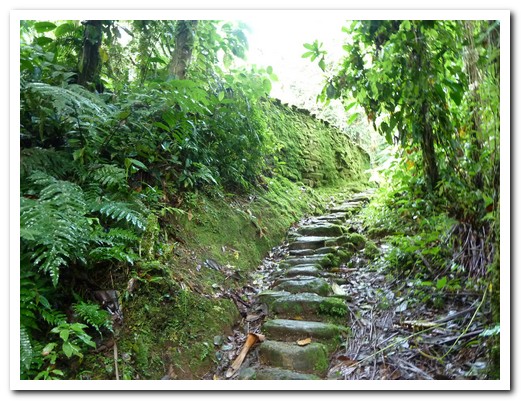
Mossy green walls
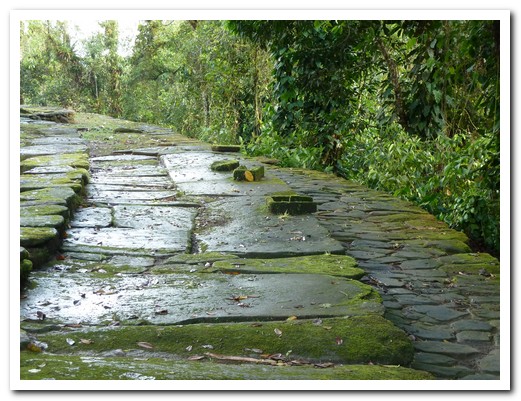
Large flat paving stones
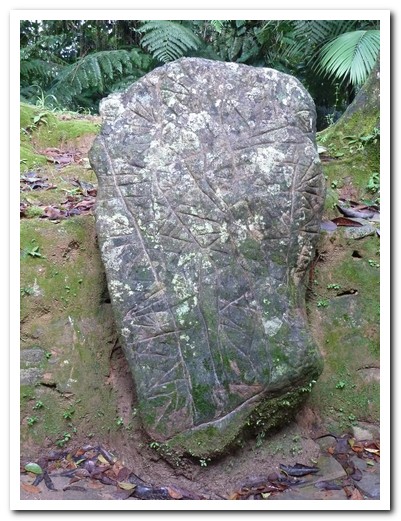
Map of the surrounding area carved into a rock
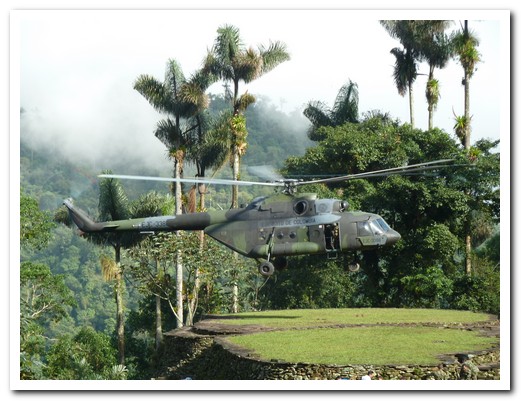
Helicopter resupplying Colombian army patrol lands on the Plaza
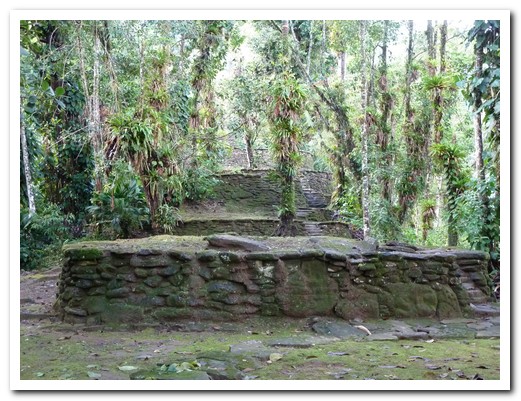
Round terraces where houses once stood
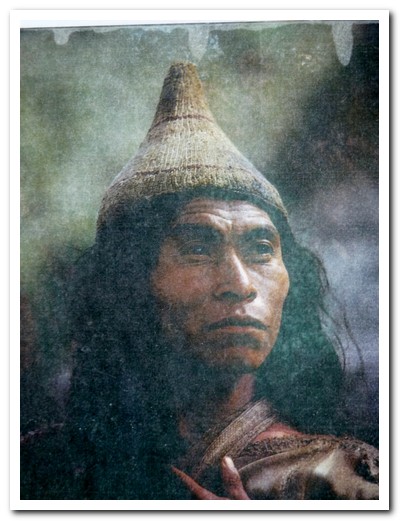
An old photo of one of the original Tyrona people